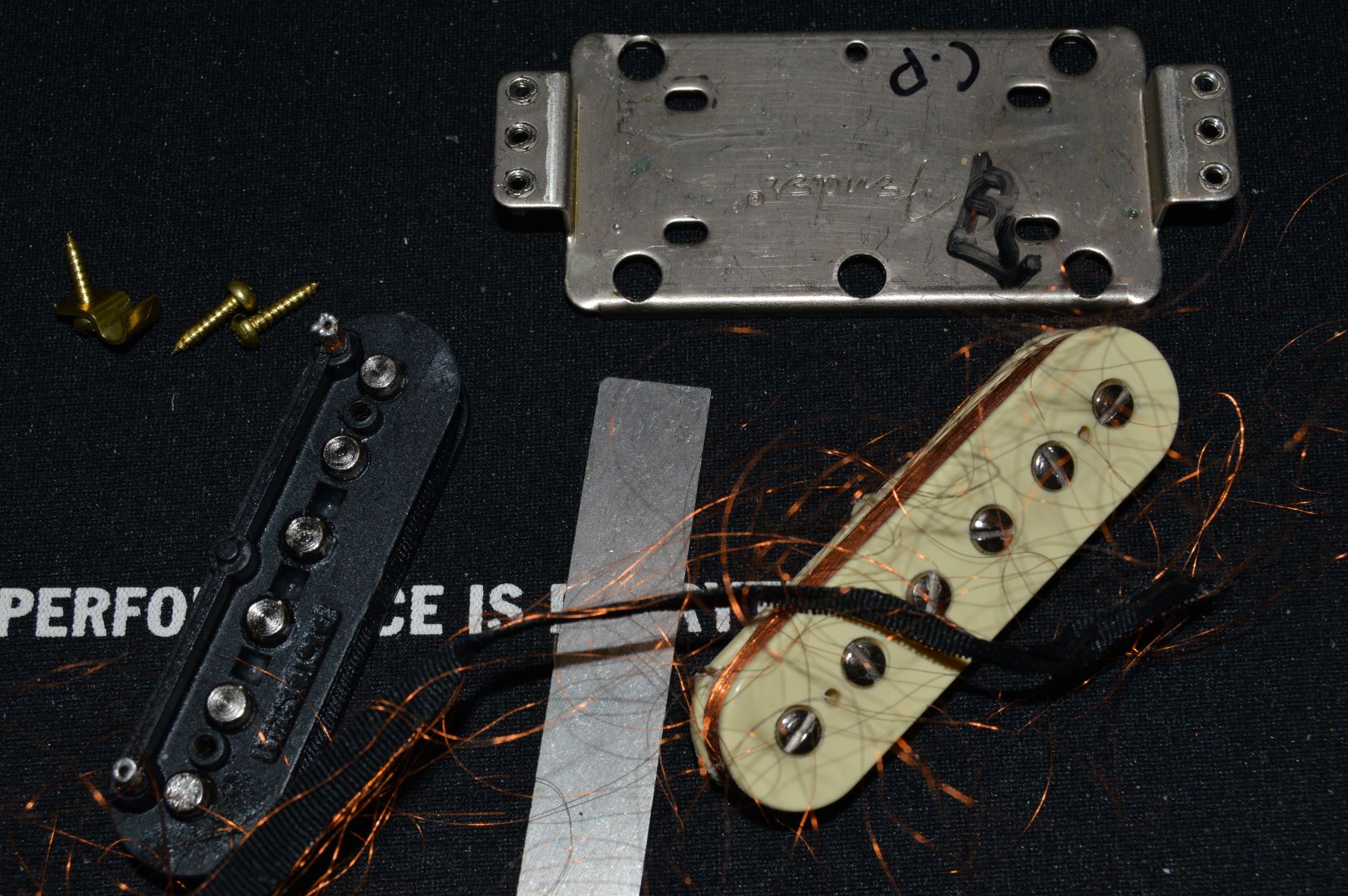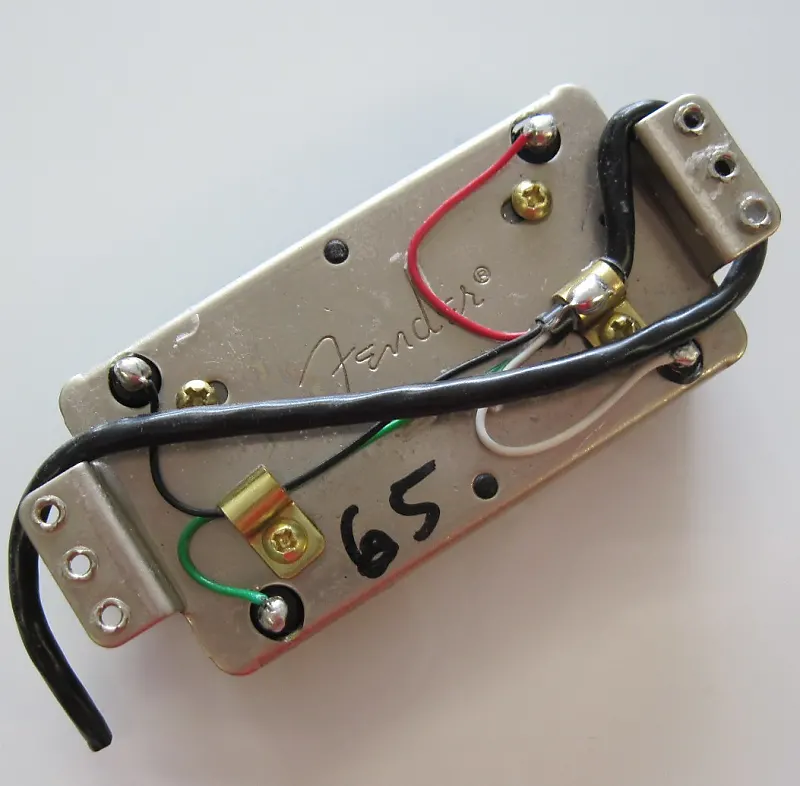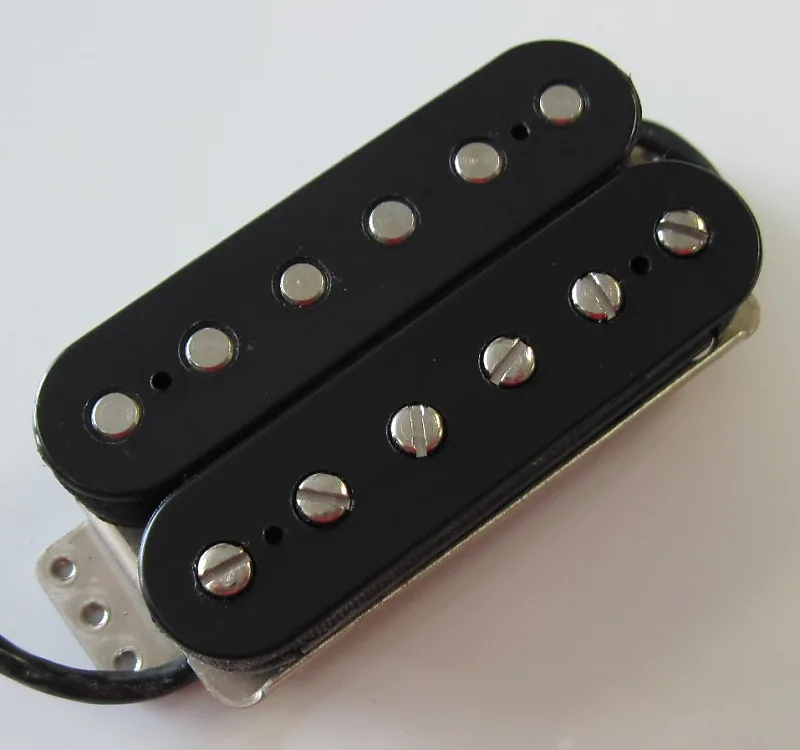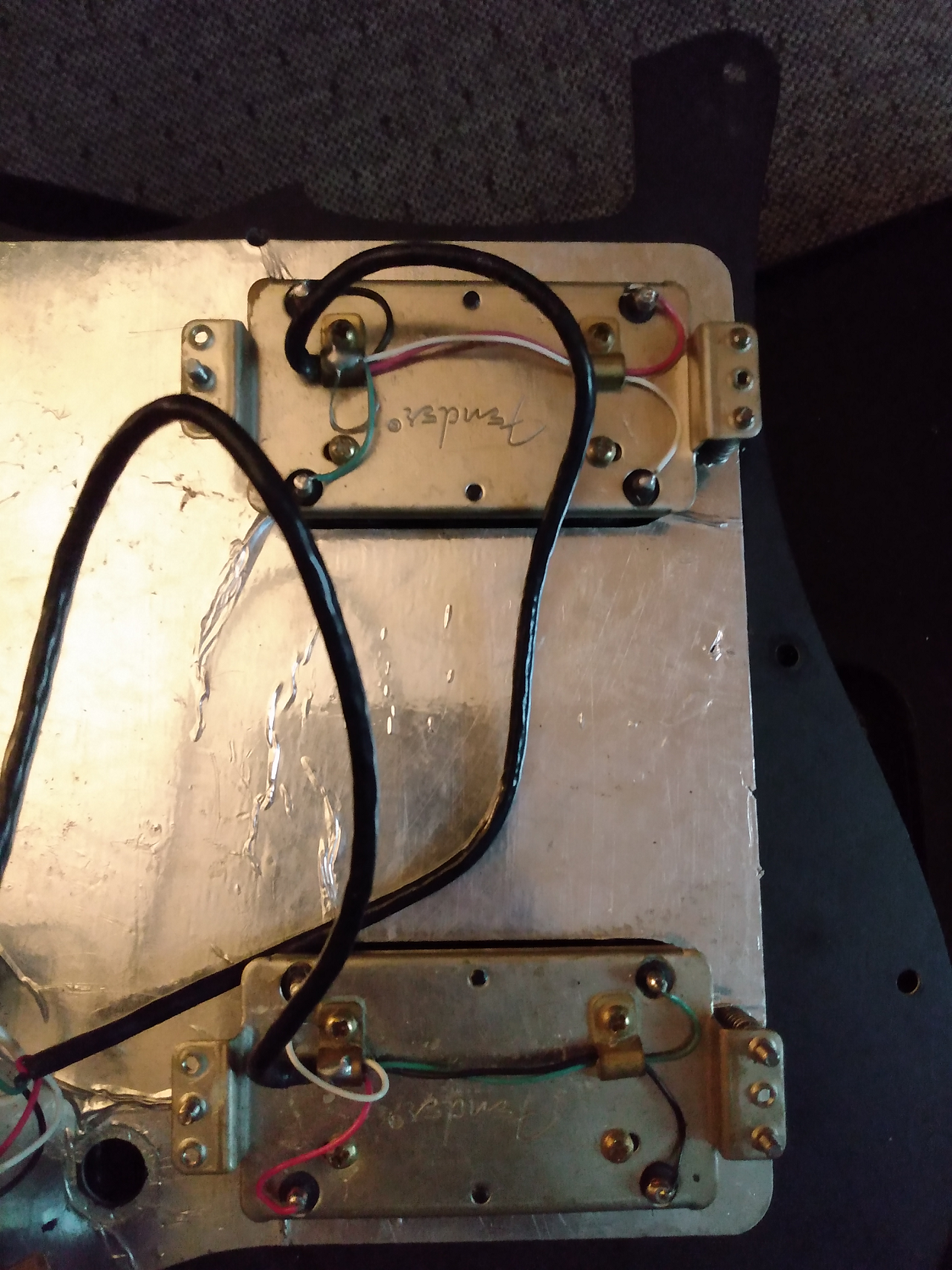FIGURING OUT PICKUPS
A great place to start is here: Fender Pickup Check List Fender typically has no “set” look for their pickups and often no number scheme or another unique identifier written on the pickup itself, usually the number of the pickup represents some or all the SKU when it does exist, but not always are all the numbers written or even written on them at all. The best way to identify them is often by looks and measurements combined. That said, some pickups, like the noiseless ones, are very easy to identify other can be dog gone hard. Bottoms, Wires and such make it a complete detective project at times because Fender would use whatever pickups they had on guitars in some cases so an MIM could show up with higher end pickups, or test runs, etc.Big Picture Info
- Don’t be fooled – The “Number” on the back of the pickup is usually a middle number in the actually part number or part of the part number, and this may change over time for the same model of pickup. Sometimes it’s rock solid so examine with caution.
- The number that is “molded” into the plastic is a BOBBIN NUMBER and is used over and over in different pickups. That just the plastic part number and is worthless for identifying pickups.
- The resistance values are approx. and can vary up to 10% in some cases or even more. The DCR are a guideline, not an absolute but in some cases they are very close.
- Pay attention to the stock wires used.
- Pay attention to the staggering on the poles.
- DCR is only PART of the sonic equation!!
REAL MEASUREMENTS (new page in development)
FENDER HUMBUCKER INFORMATION
from GG USA
Updated: 2024.06.24 – If you copy this page, please give me and my website credit. I made a big push in 2022/2023 to collect more and better information on this page. Not a trivial task.
Upcoming: More info on Wide Range Humbuckers (the resurgence)
OVERVIEW
What this is or isn’t: This page is a examination of FENDER Humbuckers and does not cover any other manufacturer.
General: When I originally started tracking these I was only including the over all look and DCR measurements. However, what I’ve found is that there are SO many different varieties and names of Fender Humbuckers, and they look so similar, so it’s hard to know what model you really have. Some of the later ones are very distinct like Twin Heads but many others just aren’t. I figured most players could get a meter and get DCR values, but to be more correct and to help identify I am also slowly adding Inductance measurements and occasionally capacitance when I have one..
Permanent Marker Manufacturer Markes: A good portion of them have numbers or marking(s) on the bottom. Those markings are typically from the part number and the same models can be released with different part numbers. Other marks are just Fender marks like SB is often used for Shaw Bucker; this type of marking if much more rare.
LOGO Orientation on install: This can be important. Although USUALLY installed with the Fender Logo oriented so you can read it from the bridge that is NOT always the case and the documentation can even orient the Fender Logo wrong. So go by wiring and wiring color orientations and don’t rely on the FENDER logo.
SLUG LOCATION. USUALLY the SLUG coil (flat ones) are farthest from the bridge and the adjustable ones closest to the bridge. I’ve even seen these come from Fender installed backwards (not by design but an assembly goof evidently).
HANDLING WARNING: Be VERY careful with dual tap Fender humbuckers (and some of the other humbuckers – Especially noiseless). If you think the solder posts are not giving you a reading. Below is what you could end up with…..unless you are careful. The wires are thin and covered with tape that will rip them apart. The are often wax potted. So be warned. Probes are the best way to check at the post, but the safest way is to try to use the wire to measure them. If you must resolder a lead, be VERY careful not to break any existing wire coming from the post. Some times the tiny wires can touch the body of the bucker and short out, watch out for that one. I have a personal trick I used, which is I put clear silicone right over the solder location, this insures that the stray wires don’t touch the body and also keeps those wires more safe from harm. On older bucker or ones that have been screwed around with, this is a great protective solution against shorting at the post.
That said let’s move on to identification
This page is all about Fender Humbuckers so they may include other Fender Guitar Models. I focused on the the last few decades of buckers but I’m started to expand to include SOME older Fender Humbuckers. Although Fender didn’t actually make that many humbuckers they often were just renamed, DH-1 has many different names. In my experience, almost all are decent to excellent. (they have their naysayers of course). Fender also had Stratocaster models that used Seymour Duncans, most notably the Pearly Gates and 59 in the early 2000s HH. But these are the exceptions.
Problems with Identification:
- BORING BOTTOMS ALL THE SAME! One down side of identifying humbuckers is that the bottoms are used over and over and over again and are often not a great indicator of the pickup and their design in most cases .
- WIRING COLORS ARE OFTEN THE SAME: The wire colors seems to be very consistent with new pickups so it’s not very unique.
- CONFUSING WIRING: The orientation of the wiring can vary creating more confusion.
- NO MARKS ON THE BOTTOM: A lot of them have NO identifying marking numbers on the bottom.
- A NUMBER MAY NOT HELP: If they do have a number sometimes you’ll have no idea what that number means and it’s usually part of their “model” number which might be the same pickup but on a different model Fender.
- SAME PICKUP/DIFFERENT NAME: Fender sometimes gave the SAME pickup a different name (like Enforcer vs Atomic, Hot Rod DH-1…marketing you know).
- DCR values can vary wildly at times: It’s not uncommon to get a large 10% or greater DCR measurement.
GOOD NEWS:
- If you DO have a part number it can help you nail it down.
- Some later models have a very unique look (like Twin Head, Double Tap)
- Some marking are unique (like SB for Shawbucker)
- Measurements can really help you zero on on the model
A WORD on part numbers: Usually fender has a long part number, the zeros in the front and end mean nothing. The part code that is important is the 5 digit code in the middle and often the last 2 or 3 digits can be found in black marker on the back of the pickup. Sometimes, they never marked them. The part code is the SAME code that would be found on a retail package. They often reissued the SAME pickup with the different part number. But, yet another but, sometimes the number on the pickup means something else we know nothing about!!
NAMING: Fender went BONKERS on rebadging the DH-1 and it’s sisters and cousins, so you’ll see it called Diamondback and Atomic also (there are more than 1 model of Atomic). – An Ohm and Inductance Meter are your best friends. Sometimes Diamond Backs have a different reading but are named the same and the documentation isn’t that helpful at times. For example they say “Fender Vintage Humbucker” – You tell me, what the HECK is that??
Marketing: It seems that later on they got more and consistent on US pickups. As a result pickups like the TWIN HEAD and DOUBLE TAP are consistent and unique with their look, and their printed numbers are always consistent..
TYPICAL WIRING DIRECTIONS
When in doubt MEASURE IT OUT! (also, measure between case and ground sometimes helps find ground).
Typical Wiring: FENDER HUMBUCKER WIRING – Except dual tap, and Shawbuckers, which are green/black slugs
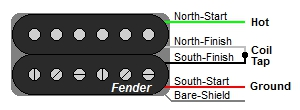
Wiring Details for Standard Humbuckers
- Sometimes Red goes to the switch and green goes to ground.
- Sometimes the White goes to Ground and Black goes to hot (Player for example)
- Typically black and white are connected together.
- Green/White is often the SLUG coil, But look on the back to be sure, sometimes it’s Green/BLACK
- The slugs are the poles without screws in them, that would be the slug coil
- Usually the Slug Coil is mounted on the neck side and the regular coil is mounted toward the bridge
- Typically the black wire from the humbucker is on the bottom left toward the switch
- Shawbuckers solder points are isolated from the enclosure.
Broken Issues
- Sometimes a solder point can be touching the body, which could connect to the shielding via the screws.
- Taking a humbucker apart requires a bit of practice and skill, and often may result in a dead pickup if you don’t know what your doing. (much harder than a single coil)
TWIN HEAD
I personally like these pickups and they are VERY easy to identify. There are TWO versions of the Twin Head pickup. They use a 3 pin connector on the back. If you buy one of these, make sure you have the cable with it so you don’t have to find one on a electric parts website (good luck with wasting time on finding them, but they are out there)! Notice it says TH-MD N – <b>The “N” means Neck Pickup. The “B” would mean bridge.</b> There are also 2 versions of this. This is the modern version. The Modern Version is hotter, higher DCR. They still can be found occasionally as NOS.
Wiring: Black (Ground), Green (Split) send to ground for a split, Blue is the full Humbucker. N = Neck, B = Bridge
- TH-MD-N (MD = Modern)
- TH-VT-N (VT=Vintage)
- IF NOT SPLITTING THE COIL THE GREEN WIRE SHOULD BE TAPED OFF AND NOT CONNECTED.
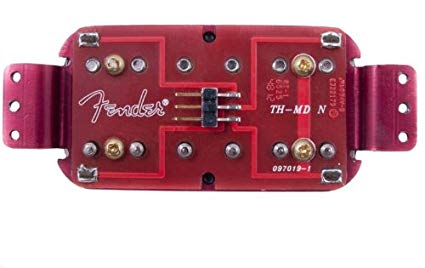
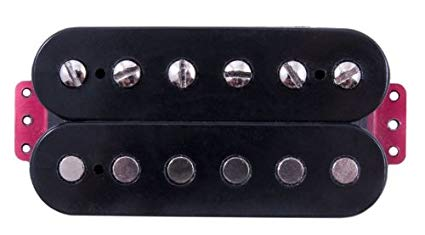
Twin Head Modern
- Alnico 5
- DCR: 15.2 k Ohm bridge, 10K Ohm Neck)
- Magnet Material: Ceramic 10.0 kOhm neck)
- Tone ratings: Neck: 8/4/6 Bridge: 6/4/6 )
- Inductance: Henries 5.1 neck, 8.6 bridge
Twin Head Vintage
- Alnico 5
- DCR: 10.5 kOhm bridge, 7.3 kOhm neck)
- Bridge: Enamel-coated magnet wire
- Neck: Forever-coated magnet wire
- Aluminum Base Plate
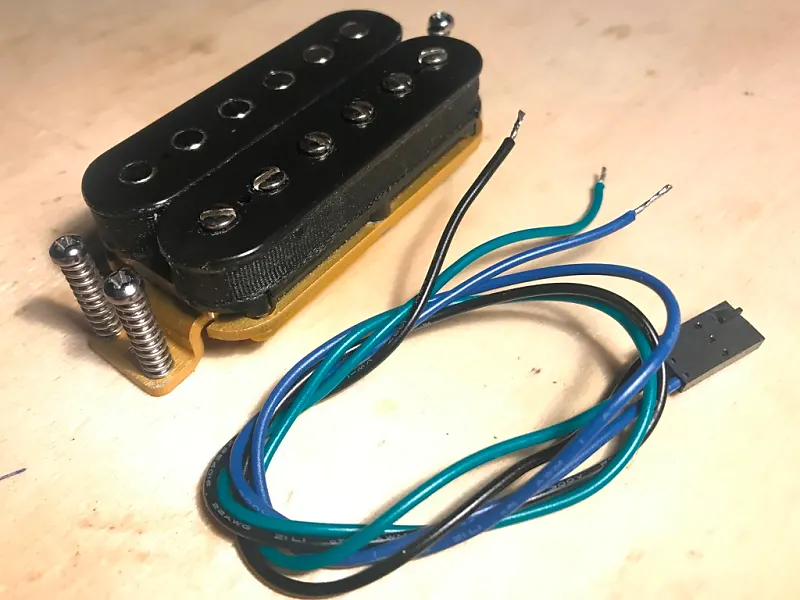
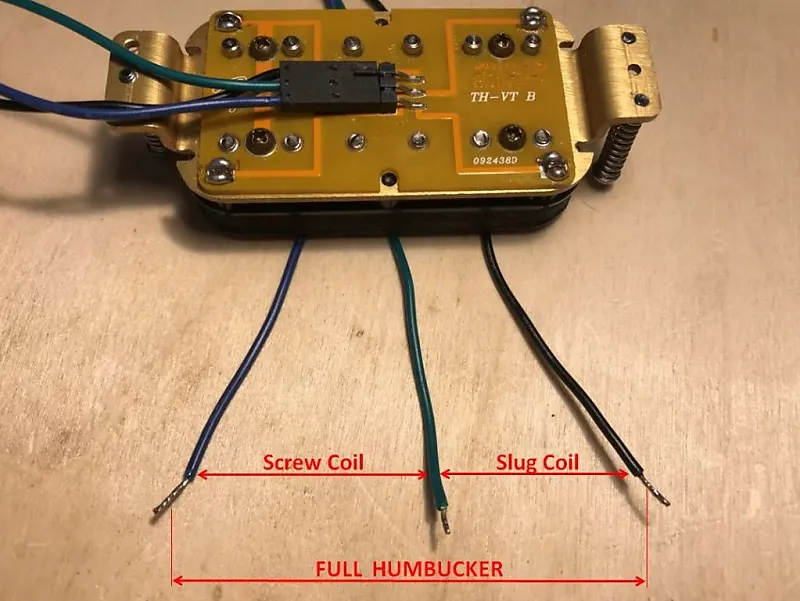
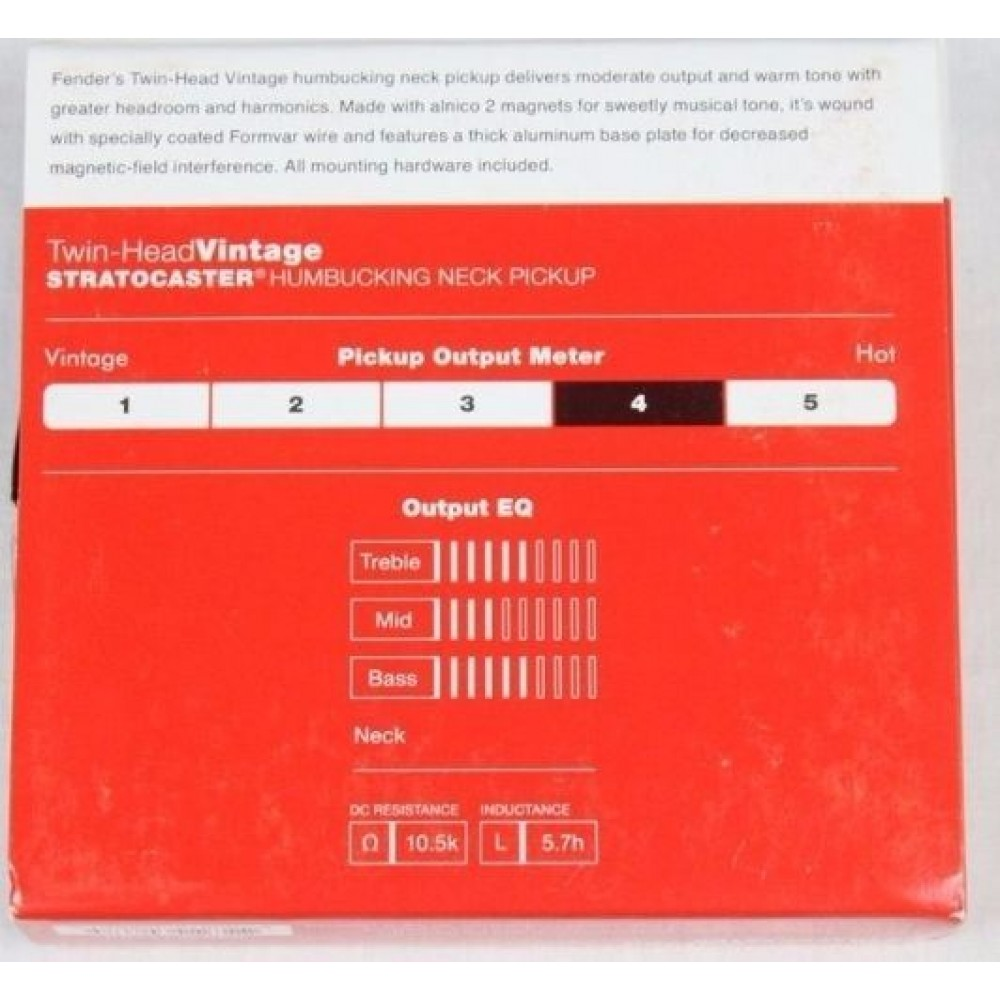
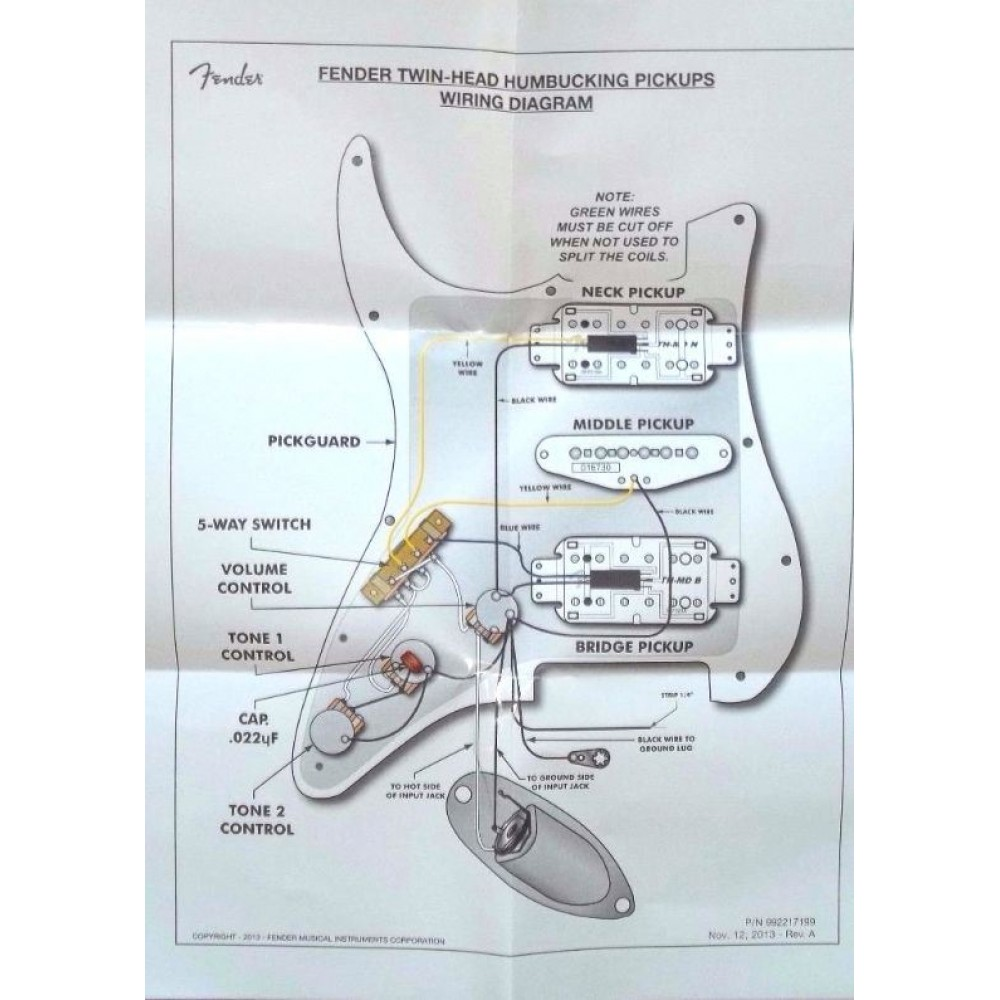
DH-1 aka Atomic (see Atomic)
OMG the most confusing model naming, specification changing, identification nightmare!!
DH-1 were on American Deluxe and Standard HSS. They are Alnico 5. DH-1 was a very bread and butter Fender Pickup. The typical measurement is 8.4K – 8.7K (I know for sure because I’ve verified with measurements). As mentioned below, sometimes these are also misnamed as ATOMIC (more than 1 model) by Fender. So they are so lax in their naming, same bucker, different name.
- DCR: Large Range from 8.4K to 8.8K with the typical being about 8.5K – 8.6K
- Magnets: Alnico 5
- INDUCTANCE: approx. 5.3H
- DH-1 are Fender rated at 6/4/6 (bass/mid/treble) so they are VERY balanced but slightly scooped.
- DH-1 Numbers: 58034 (34 on the back), 63265, 64 (and many others)
ACTUAL DCR/INDUCTANCE READINGS (about 5+ of them):
- Inductance: 5.1- 5.3H
- DCR: 8.5K – 8.8K
- Numbers: 34, 64
Some Part Numbers from a Fender Parts guy – Same pickup, different color coils.
- 05-3758-000, DH-1 Humbucking Bridge Pickup, White Coils
- 005-3689-000, DH-1 Humbucking Bridge Pickup, Chrome Cover
- 005-4036-000,DH-1 Humbucking Bridge Pickup,Aged White
- 005-3717-000,Atomic Humbucking Bridge Pickup, Black/White Coils
DESIGN Goal: The “Atomic Humbucker” or DH-1 was intended to kick up the mids in the bridge position
See this picture and just change the numbers. The wire colors are the same. They sometimes install the coil flipped with the dummy coil on the outside.
Pile of 3
IN THIS PHOTO NOTICE THE DH-1 IS MOUNTED INCORRECTLY, IT SHOULD BE BLACK ON THE LOWER RIGHT INSTEAD OF WHITE. The Fender should read by looking at it from the bridge.
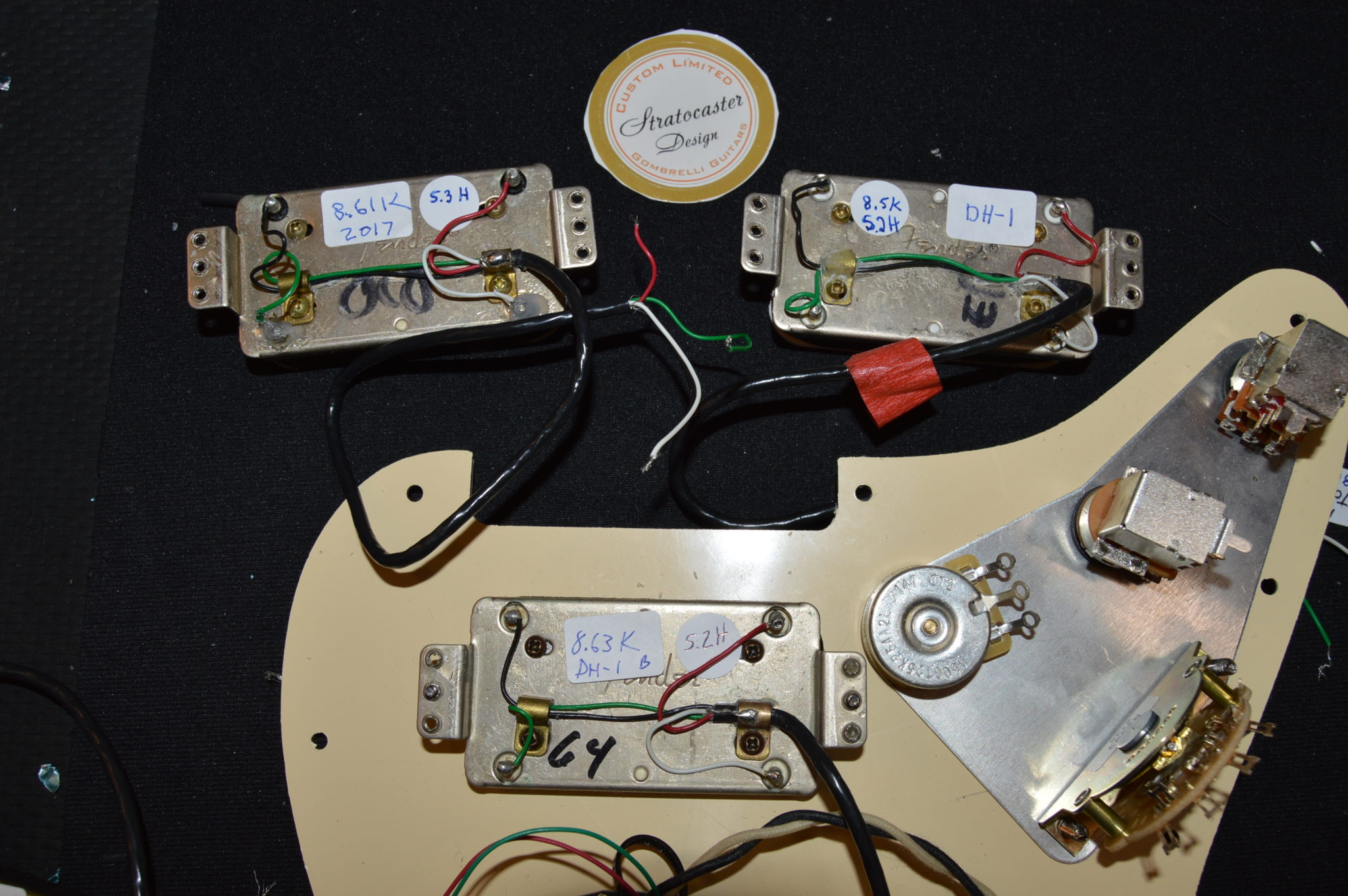
006-3265-000 DH-1 Black Bridge
005-3689-000, DH-1 Humbucking Bridge Pickup, Chrome Cover
005-4036-000,DH-1 Humbucking Bridge Pickup,Aged White
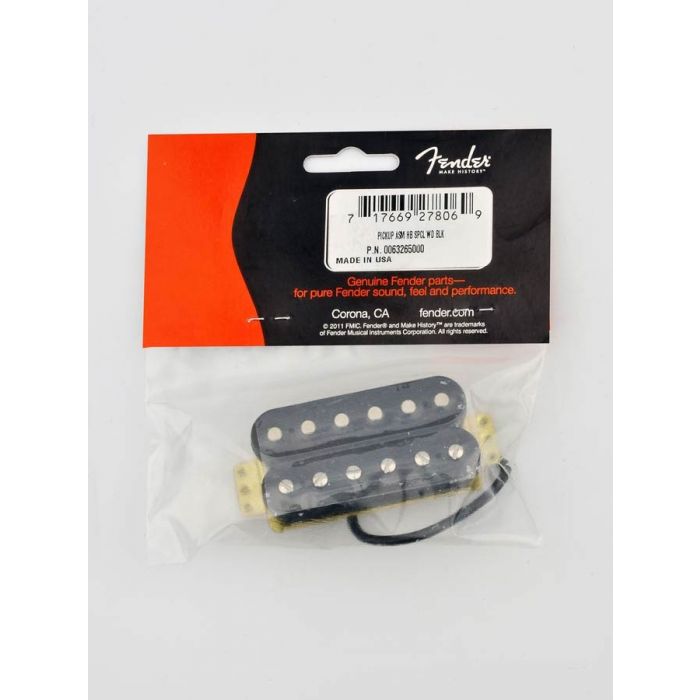
DIAMONDBACK
TWO VERSIONS! – Fender used this name for 2 distinctively different versions of this pickup. One is a vintage and the other is actually the same as a DH-1 – The vintage one was release in a commercial package. Thank goodness the later humbucker became more unique!!
I don’t know the exact construction difference but a sure fire way to tell is the huge difference in INDUCTANCE.
VINTAGE
- DCR: Approx 8K (or all around that number)
- INDUCTANCE: 3.25 – 3.4H
- Magnets: ALNICO 2
- Real Measurements: 7.8K and 3.25H
- Power Rating: 4 out of 5
DH-1 Renamed? May use larger wire guage
- DCR: 8K ish (Number lower than a typical DH-1)
- Inductance: 5.4H ish (Number about the same as a DH-1)
- Alnico 5
- Look the same
The front and back look exactly like all the rest. This is a retail “Vintage” package. (Vintage is my term)
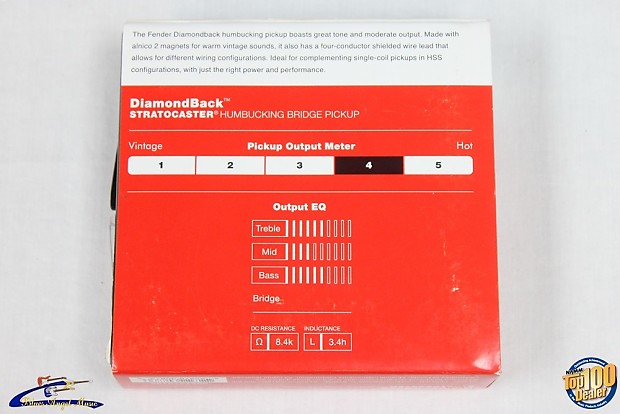
ATOMIC
2 Versions – Vintage (neck) and Hot (Bridge)
This is important to realize there are 2 distinct versions of this or you’ll be endlessly confused. You have to measure to know and get the inductance value, they look the same with some minor differences.
Atomic pickups are a GREAT example of heavy use and LOTS of different “sku” numbers and to make matter even worse they seem to have both a VINTAGE and OVERWOUND version. One used in the Bridge typically and one used on the Neck typically. Finally the number on the bottoms often doesn’t match the SKU number. The Atomics showed up in a lots of guitars but one of them was the Fender Tornado around 1998. They typically have a BLUE (Neck) or BLACK plastic lead, Blues are typically the lower value.
Models used on: Tornado, Fender AM Deluxe, Telecaster, Cyclone, Floyd Rose
One other note: Sometimes Fender or players have referred to the DH-1 as a ATOMIC! But there is more than 1 model of them but otherwise are the same.
How to Identify: The easiest way to identify these is what guitar did they come out of, what did they measure, and what is the number and what is the inductance.
NUMBERS: 0053717 (Bridge), 65288 (Tornado Bridge), 53691, 53689 (others)
Overwound Bridge Version
- Typical DCR: 15.5k to 16K
- Typical Inductance: 8H +/-
- 005-3717-000,Atomic Humbucking Bridge Pickup, Black/White Coils – 16.3K
- 60835 ATOMIC – From bridge on Tele – 16.4K (typical high DCR) INC 8.5 Henries – Alnico V
- 53691, 53689 – From a 1998 Tornado
- 59190 – From an HH Neck
“Vintage” Neck Version (found on HH guitars and found on Stratocaster Deluxe HSS) — Later might have been referred to as a Diamondback
- DCR: 7.9K
ATOMIC – Numbered 326 – Bridge Atomic numbering 326 is used on 2010-2015 American Deluxe Stratocasters with N3 Noiseless pickups.
A comment made in 2000 by a Fender R&D guy was this (excert)
“….The “Atomic Humbucker” was merely a product name chosen to highlight the Toronado and Cyclone guitar models. This pickup is featured in the bridge position on the Am.Dlx. Fat Strat, and it is called the DH-1(Bridge). It is also featured in the bridge position of the Floyd Rose HH and HSS Classic Strats, and is also called the DH-1….”
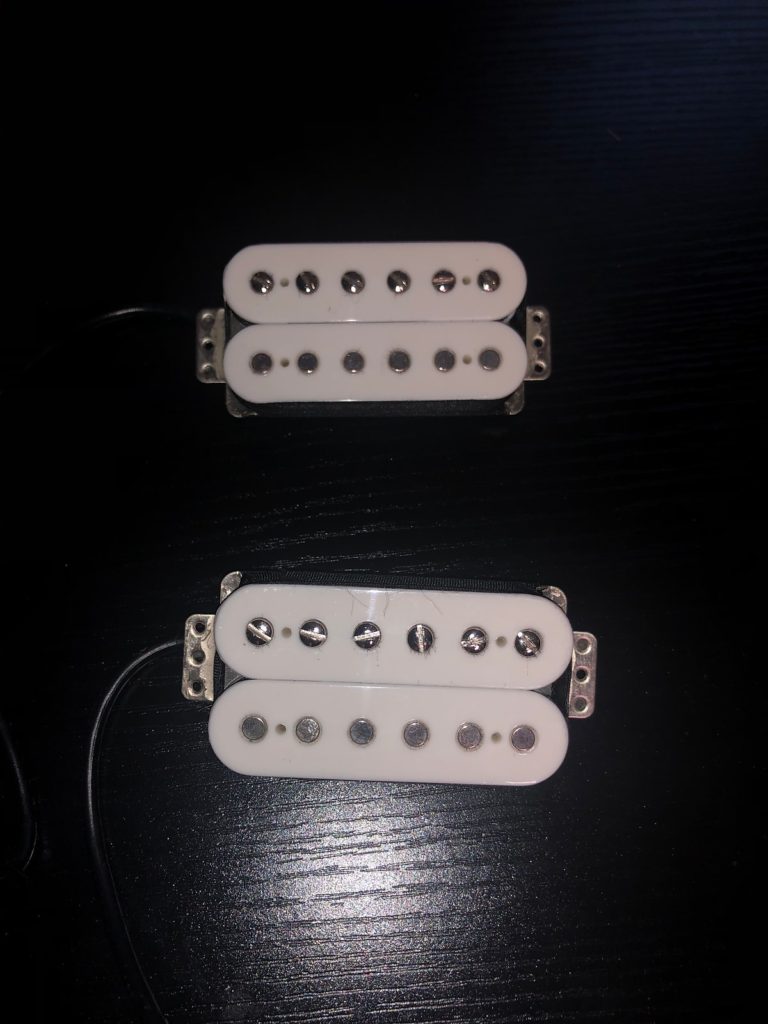
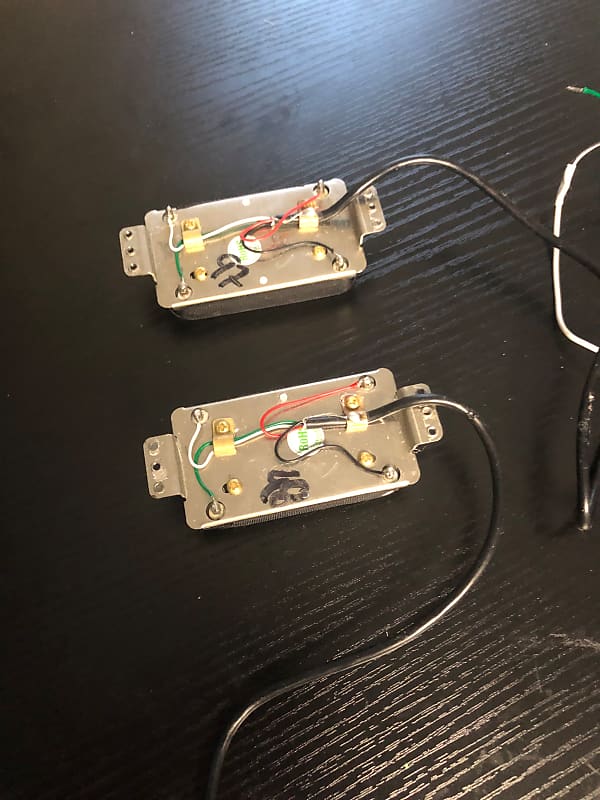
Notice the 97 and 98 on the back
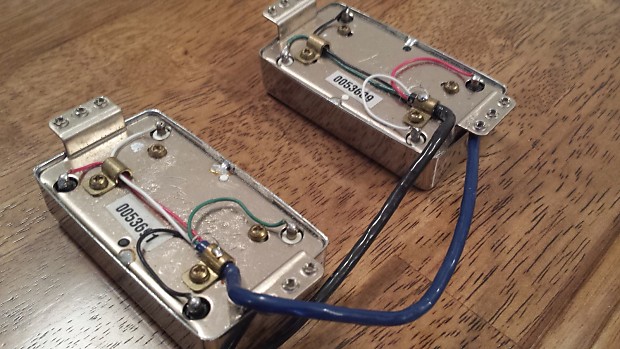
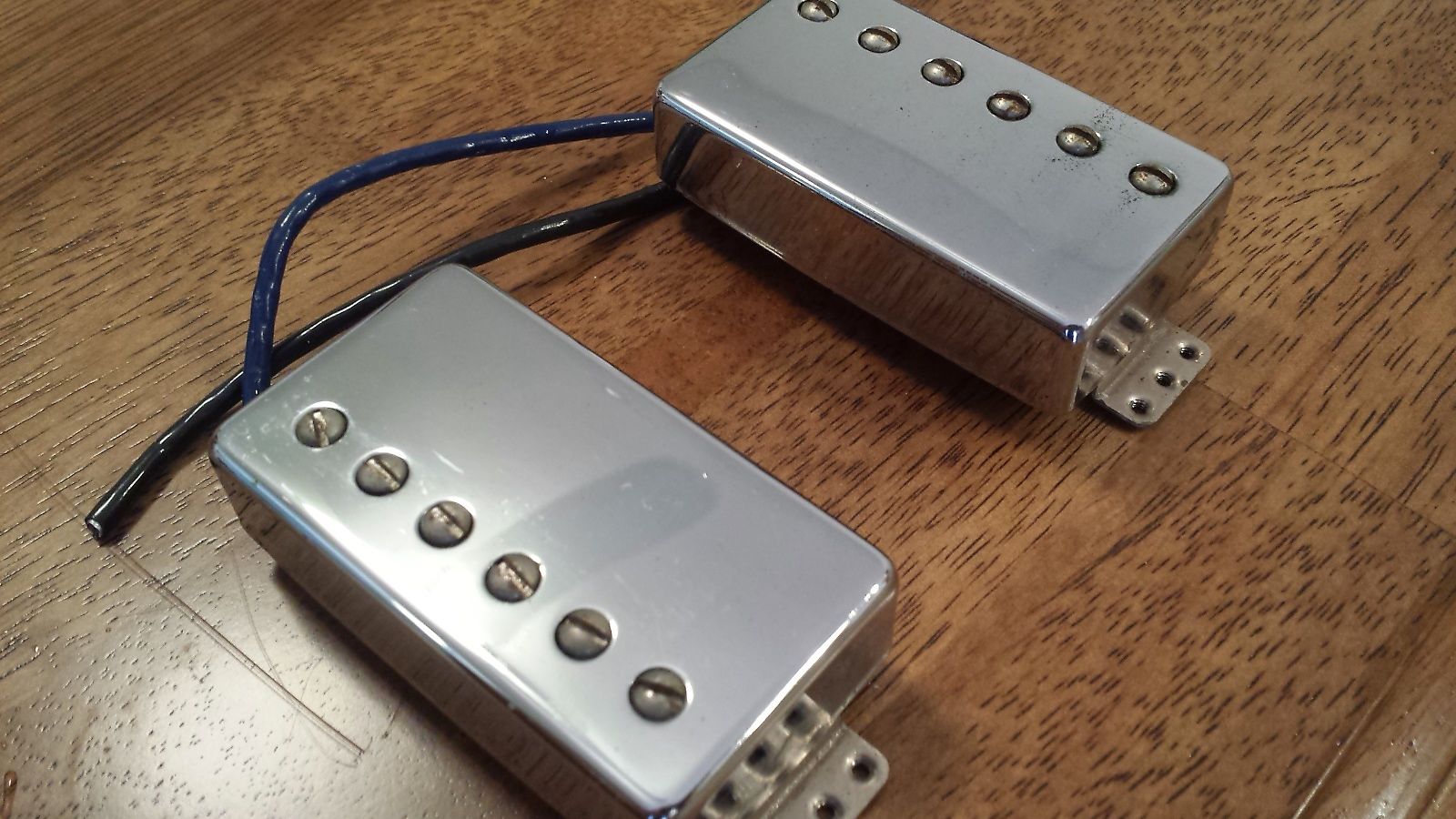
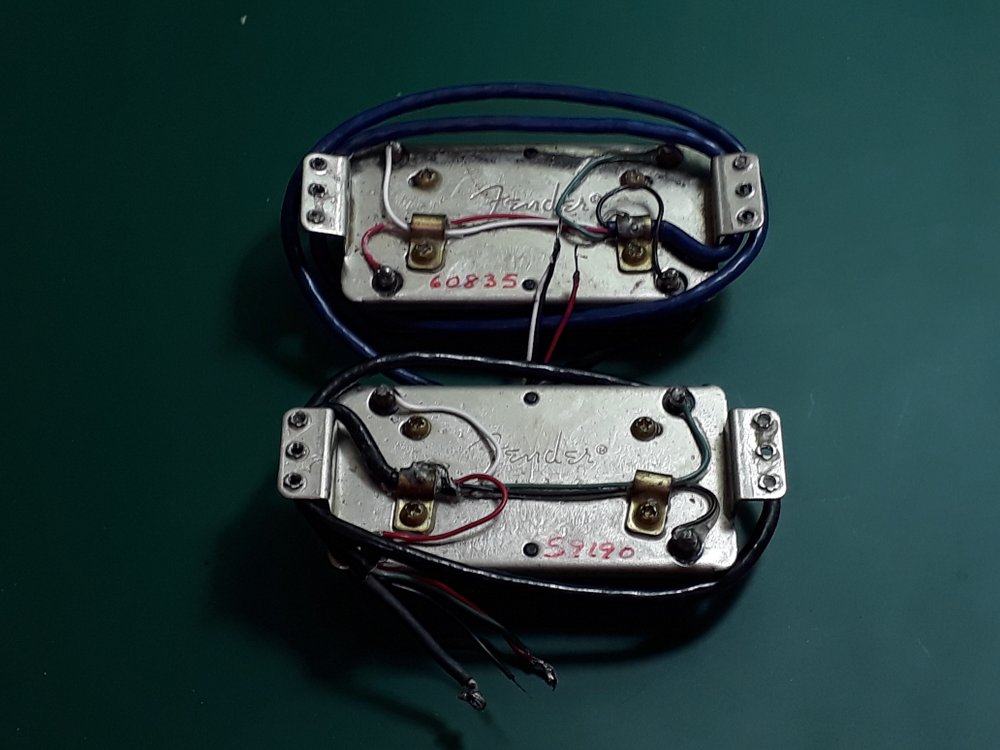
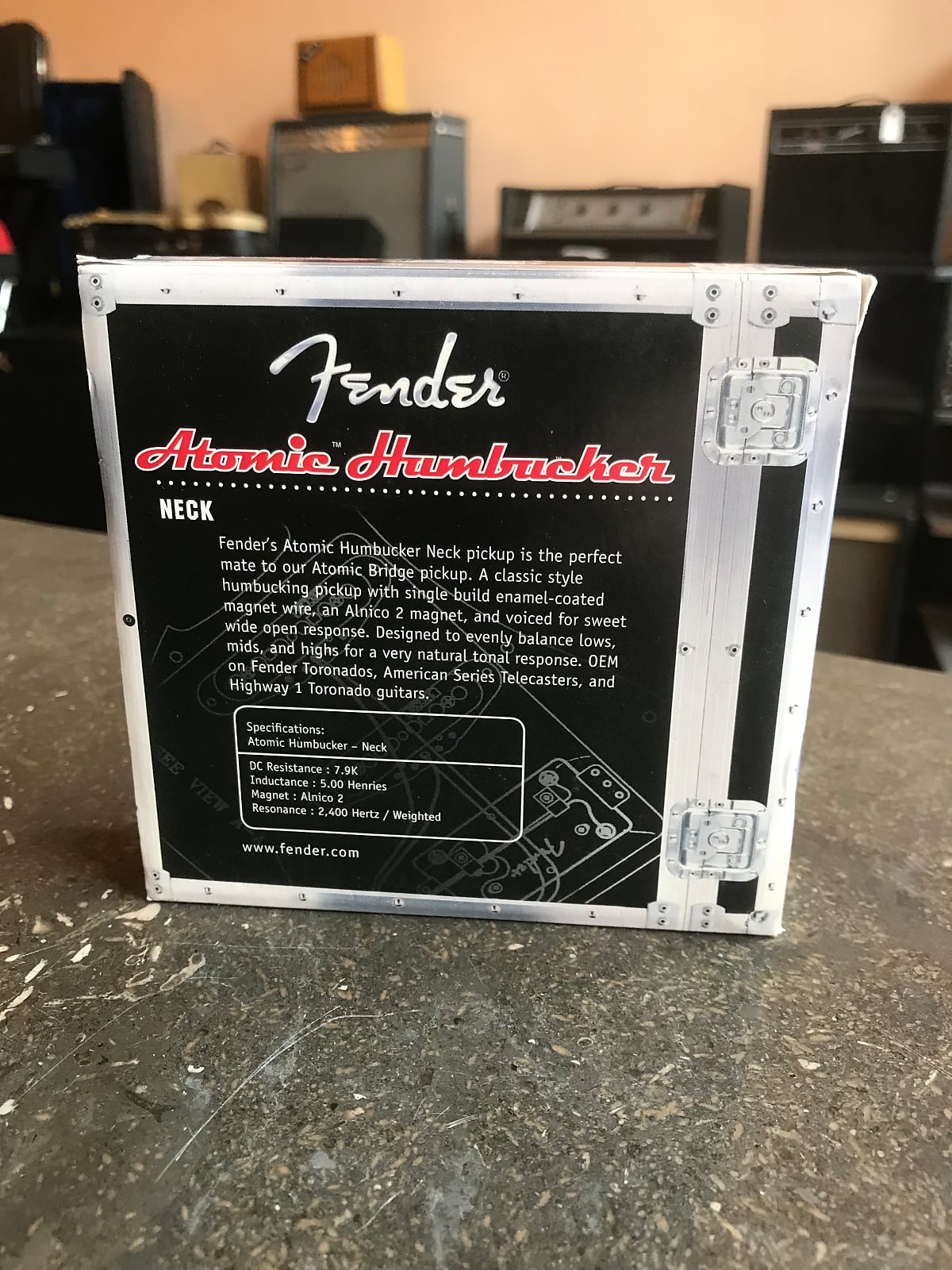
Shawbuckers
Shawbucker 2 has a higher output than Shawbucker 1 – Shawbucker 1 is recommended for HSS and Shawbucker 2 is recommended for HH configurations. Fender still sells these as of May 2020
- Shawbucker 1
- Years: 2106 to 2020
- Anico 2
- 7.6K, 4.0 Henries
- Mated with Fat 50’s single coil
- Used stacked pots 250k/500K
- Requires 500K for Shawbucker
- Model: 099-2249-001
- Shawbucker 2
- Years: Not Sure, I believe this only came on HH versions in the Bridge
- Requires 500kΩ potentiometer
- Anico 2
- High Output
- 7.8K – 4.5 Henries (not that much more than Shawbucker I)
- Model: 099-2249-002
Came On
SHAWBUCKER – Elite Stratocaster (not sure which model)
Sidewinder (Neck) & Black Cobra (Bridge)
WATCH OUT. The wiring on these pickups in the HH Strat is hard to understand and is NOT like any other one.
Released 2003 to 2006
- HOT Ceramic
- DCR: 24K
- Inductance: Unknown at this time
Black Cobra – 16K typical – Likely the same as Atomic
Not much info. I do know they were released as a pair in HH Stratocasters. This one is dated 2005. They are very High output which means they are very dark pickups. I wouldn’t use anything less than a 500K to work these.
The number for the Black Cobra is 65290 (the 290 is the important part, fender sometimes leaves out the first 2 digits which are typically 65).
DCR:
- BRIDGE – Black Cobra: 16K – 63274, 64190 (Atomic?)
- NECK: Sidewinder: (Atomic) 16K – (often referred to as an overwound Hot DH -1) – 65290
See: Sidewinder – Enforcer
See : Black Cobra Atomic
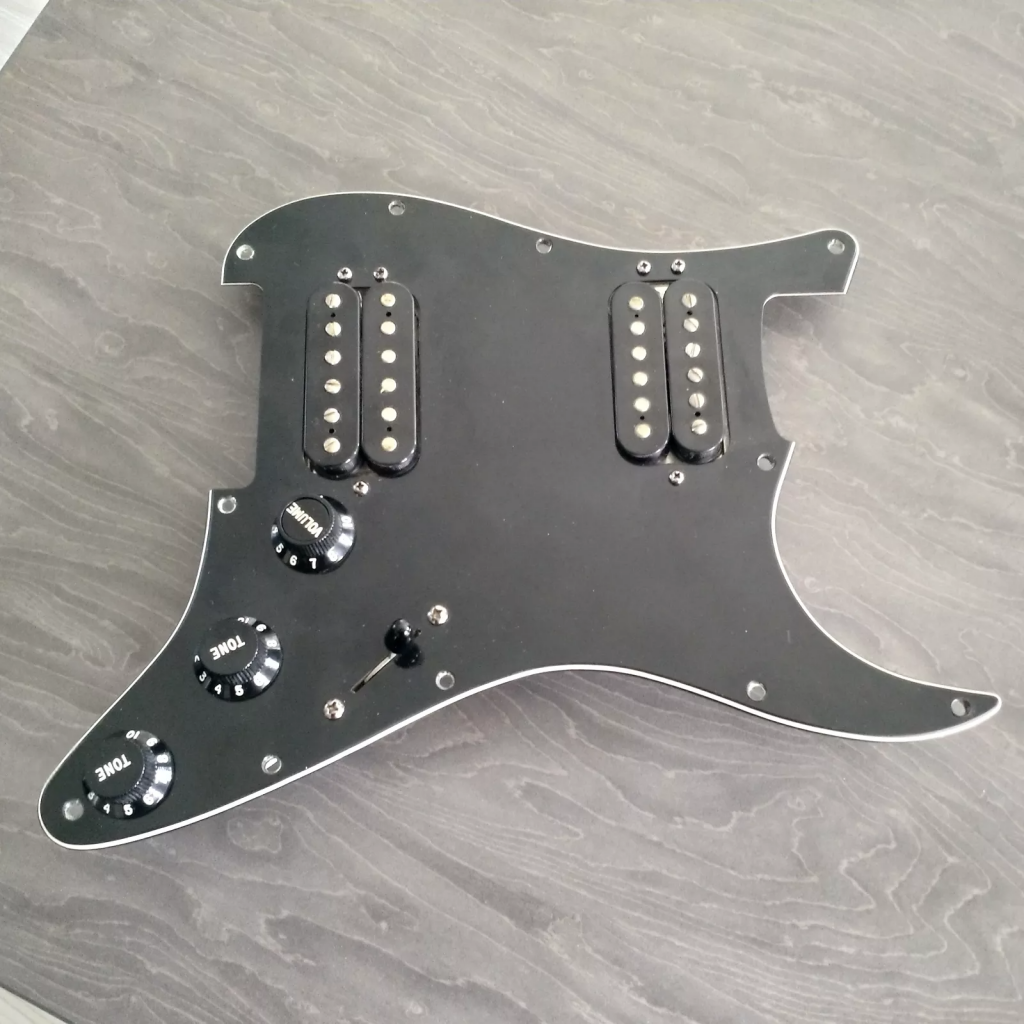
Notice the mount direction is FLIPPED with the HH guitar and the Bridge and pickup poles are reversed but both the LOGO’s are in the same direction toward the NECK.
So these pickups are set up DIFFERENT than the HSS version! The slug coils are in the middle.
I found this to be one of the most confusing setups I’ve seen because there isn’t a diagram to should the actual coil and the wiring just doesn’t match anything and isn’t consistent!
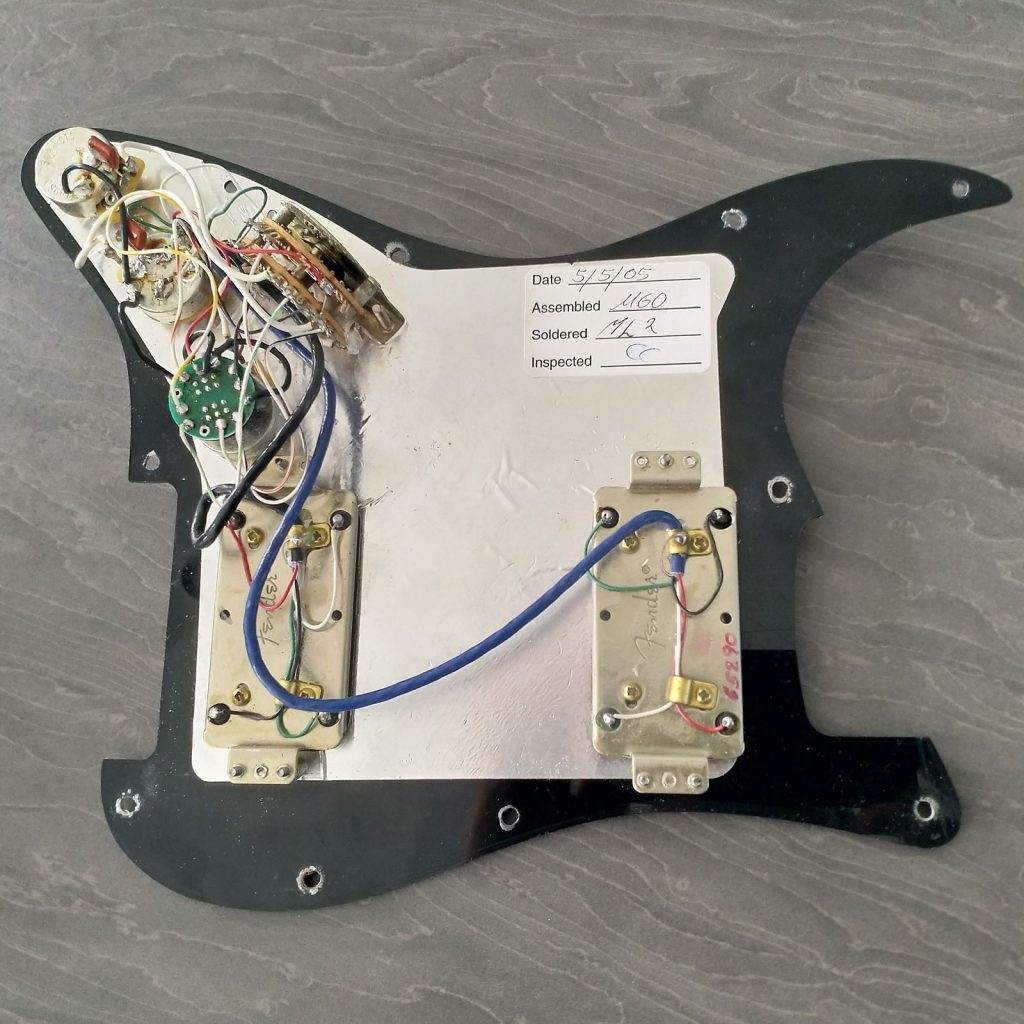
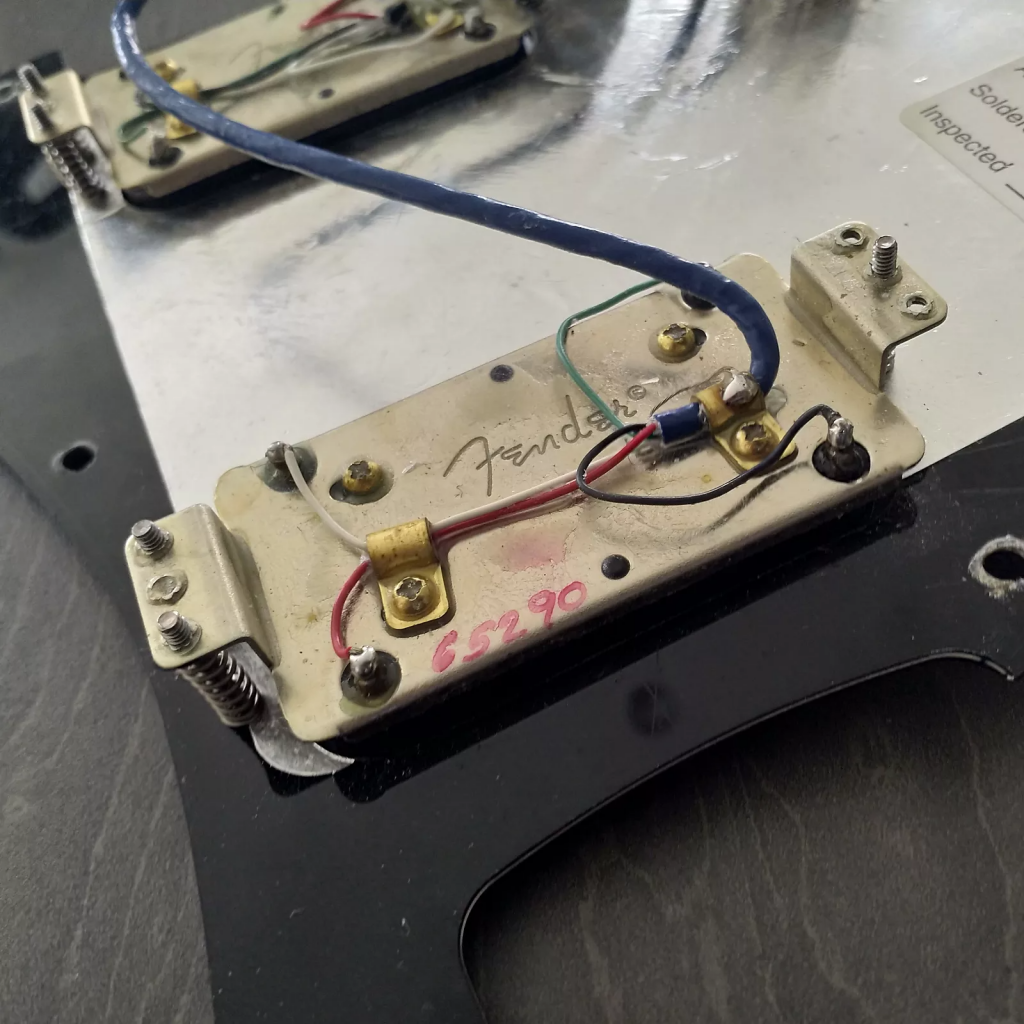
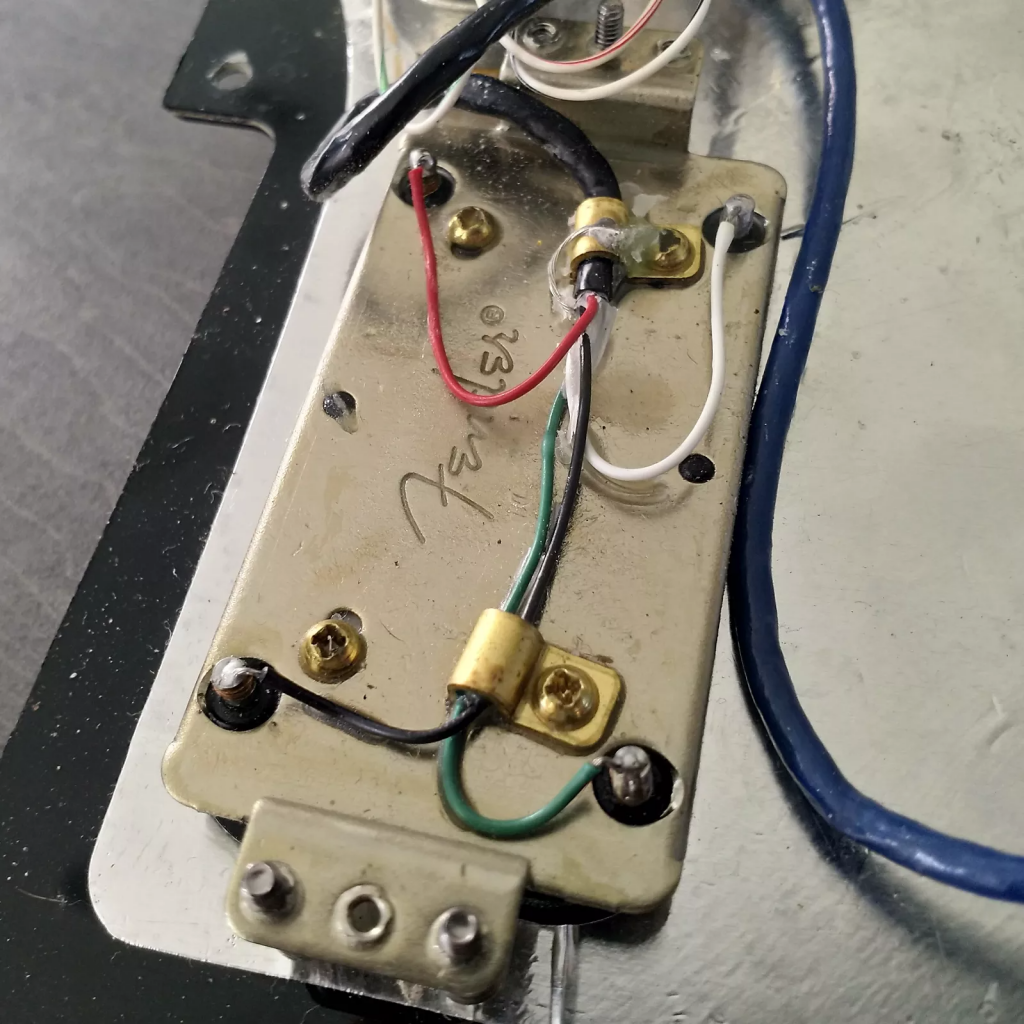
Enforcer Pickups
- Very common, Used in Tele’s, Jaquars, Pawn Shop Deluxes and a few Strats.
- Aged white, bridge position.
- High output with ceramic magnet. (Ceramic 8)
- 4-conductor lead for split coil and series parallel wiring options.
- 2-3/32″ pole spacing
- The number to look for is the 235 and 236 for the Bridge. It’s is written many ways but those are the main numbers that identify it, the first 2 numbers can either be there or not.
- Note: The number 236 is also used for ATOMIC humbuckers.
- Sometimes only the LAST number is on the pickup (ie: 5 or 6)
- DCR: 24K (actual measurement 23.57K)
- Inductance: 7.5H
- Pawn Shop Deluxe series
- Telecasters: 65287 and 65291, 74315 (Telecaster)
- Jaquar – 6235 and 76236
- Note: Squier series Jaquar do not use these.
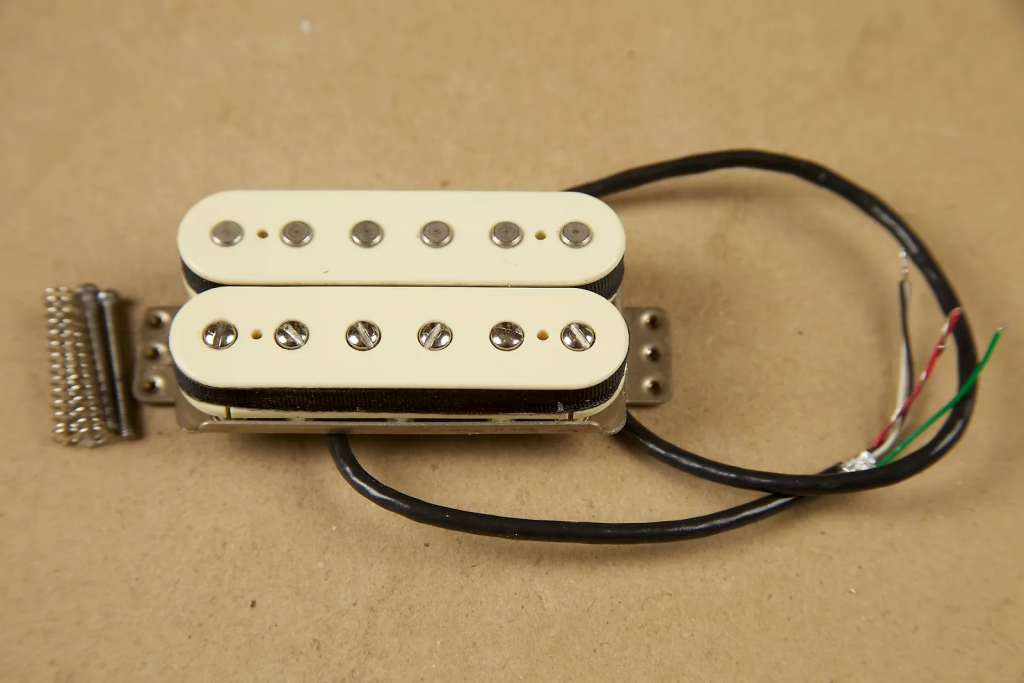
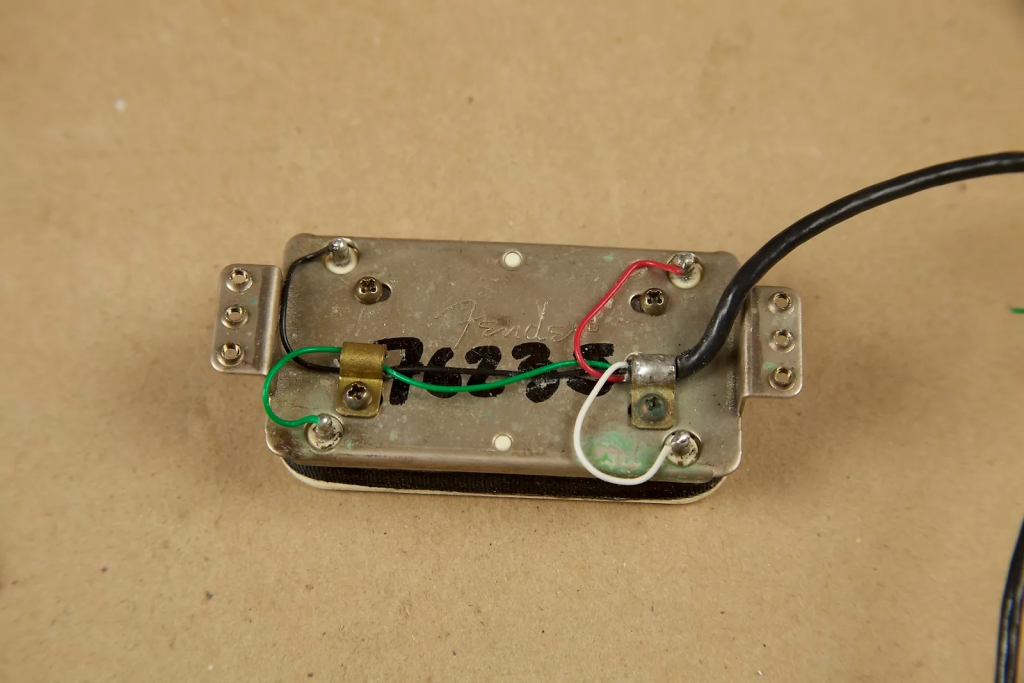
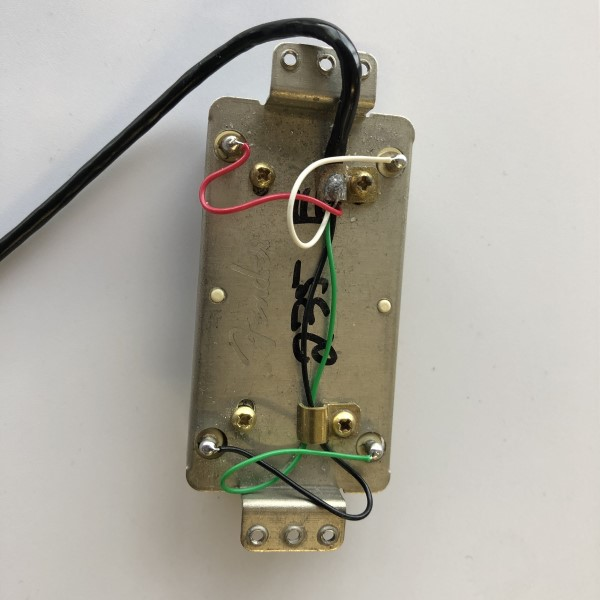
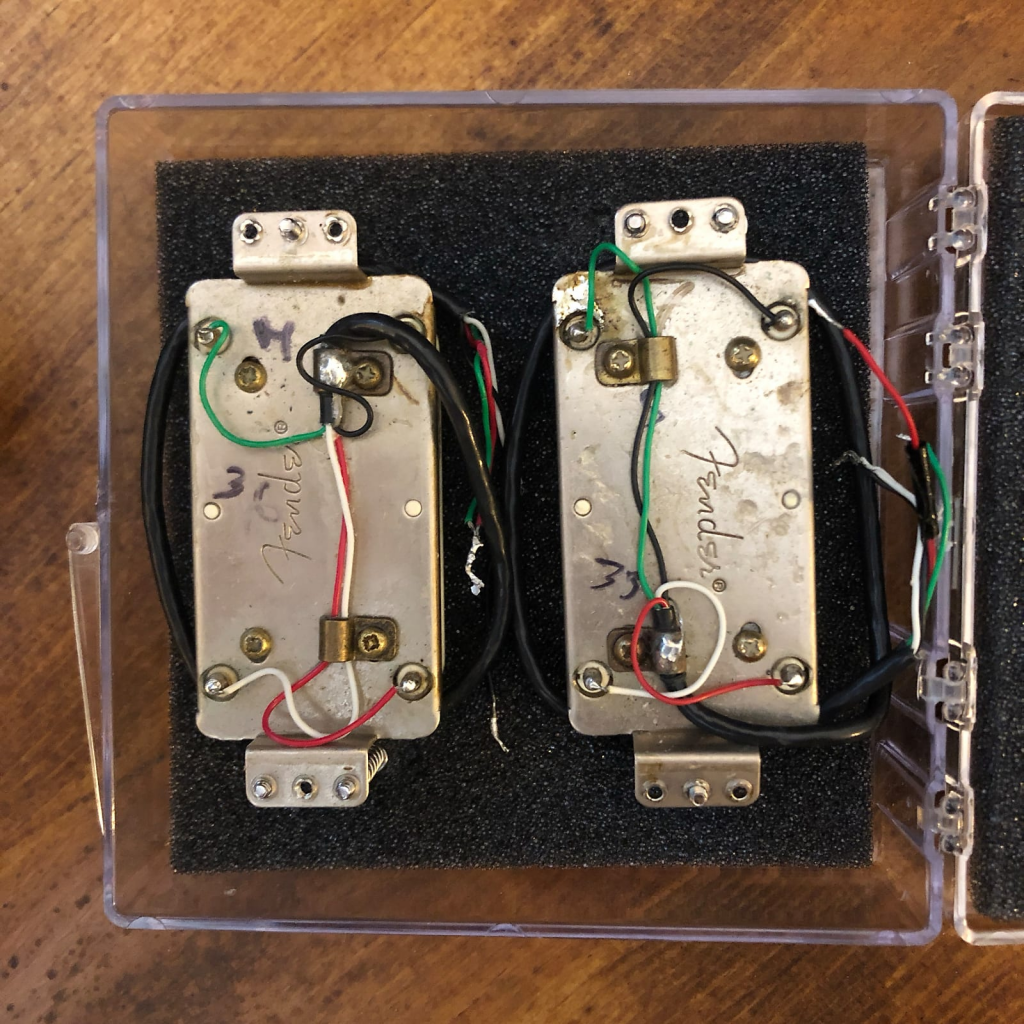
American Standard Single Coils on HSS versions
The American Standard single coil pickups are actually Tex Mex pickups until 2013 then they were replaced with Fat 50s
Double Tap
WARNING:!! – Dual Tap Humbuckers have posts that go into the pickup bobbin and tape around them windings glued. If you BREAK the little wires going to the posts by putting clips on them on the pickup body, or resoldering them the pickup is likely toast unless you plan to rewind it. But rewinding a double tap is only for the intensively obsessed and wicked! If you try to pull off the tape you’ll also find that it’s literally GLUED to the wires so you pull that off, and a bunch of windings will be ripped apart. Below is what you will end up with. Dual taps a real problem because of the tap. The normal ones aren’t TOO bad to rewind if you know what your doing but even that isn’t a job you’d want unless your have a winder, etc.
This is one of the newer ones designed by Tim Shaw. It’s Alnico 4 and clocks in about 8.4K DCR. It’s on the performer Stratocaster with 2 Yosemite single coil pickups. It’s interesting that fender is very consistent about having their HSS humbuckers about 8.5K or so. with a scooped midrange. The best way to tell, is that THIS one has an extra wire in the middle of the back of the bucker.
- No volume loss in single-coil mode
- Wax-potted to control feedback
- DC Resistance/Magnet Type:8.5KΩ
- Poles: Alnico 4
- EQ: Bass 8/Mid 4/Treble 8
- Power output: 3
- Number written on the back can be 82
- Currently for sale by Fender, $120 on the street, definitely under $100 used.
- Identify mark on back is an extra red lead coming out the middle of the back.
- Some early “Ultra” guitars have N4 Pickups, not Ultra, you can tell by the back of the single coil pickup. I’m not sure these humbuckers changed with the Ultra series.
What series did this come on? Performer (2018), Professional II (since 2020)
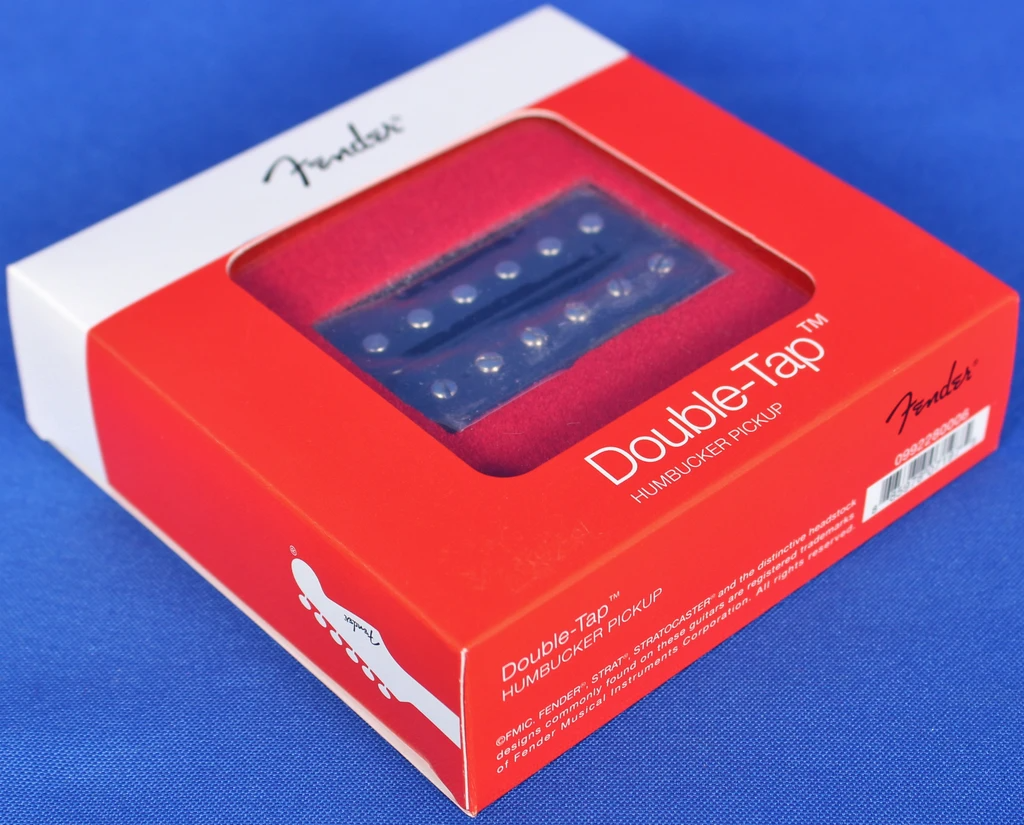
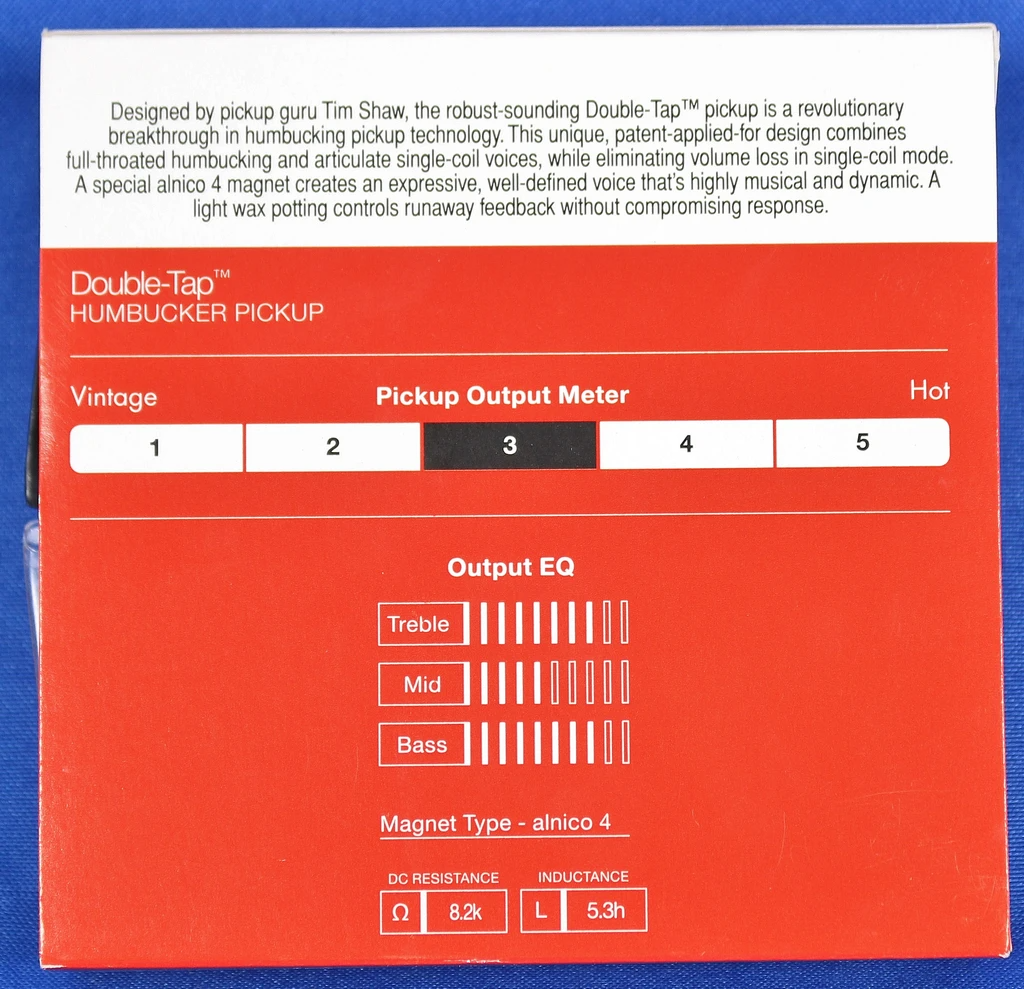
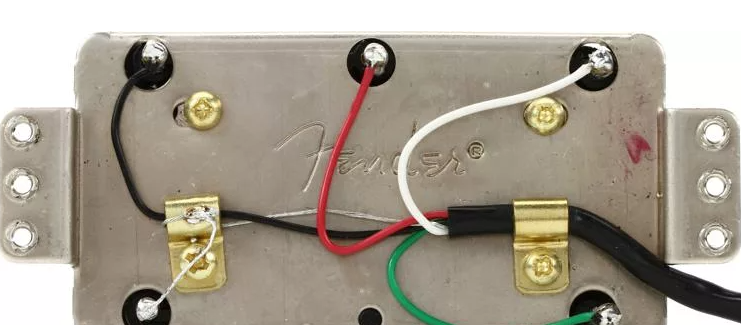
Standard Humbucker
The numbers of neck=50945 bridge=50955 often show up on them but not always. They measure around 7.5 to 8.5 depends on the run. My impression is that they are someone non specific and may be different batch to batch. But I have found that some of there really sound good, and some are just ok.
Fender representative refer to these as Non Specific Standard Humbuckers. They are on MIM HSS guitars usually.
Numbers: Neck: 50945, Bridge 50955 – 50950 (A VERY standard MIM Humbucker)
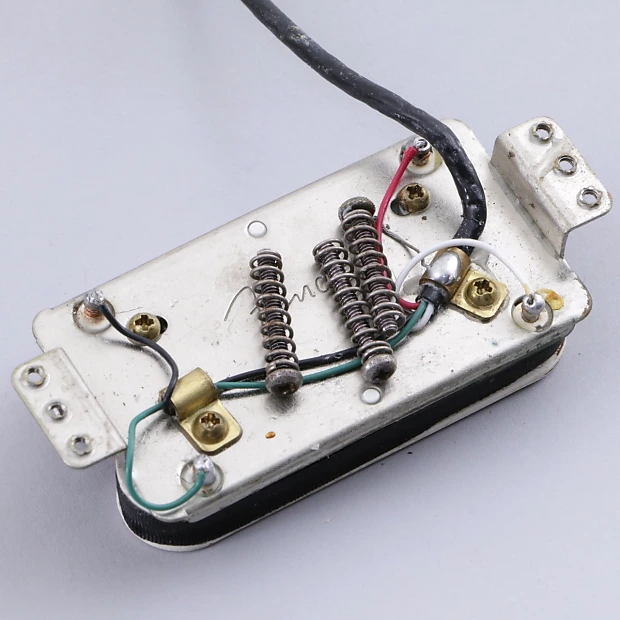
This one measures 8.5K or about the same as a Diamondback. It could actually be the same pickup when Fender didn’t have others available or had overstock. Fender is famous for renaming their Humbuckers (see DH-1/Atomic).
NOTICE ON THIS ONE THE SLUG COIL IS MOUNTED TO THE BACK TOWARD THE BRIDGE BUT AT LEAST THE WIRING IS CORRECT, so they got the mount incorrect at the factory but it works.
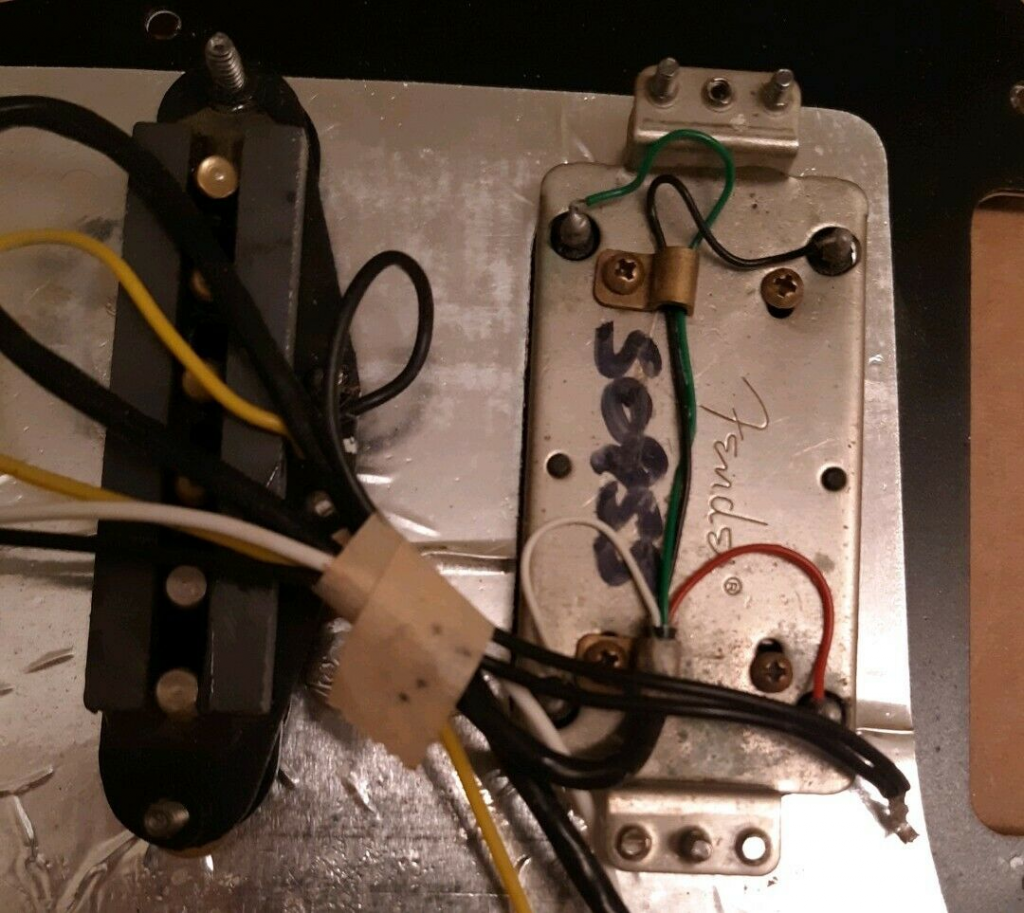
Player and Meteora Series Humbucker
Updated: 2022.11.18
WIRING TIPS: The wire color locations are DIFFERENT than the Standard DH-1 HUMBUCKER, pay close attention.
The data is now in on these guys. Fender recently has been “cross pollenating” their single coils and humbucker into other models than just Strats. Likely because they are actually darn good pickups.
- The LOGO slightly thicker than any logo in the past. It’s in the usual location more or less or maybe more toward the top instead of centered.
- The metal chassis has a more “gold” look about it than the older pickups which looked silver
- Fender Models: HSS Player Stratocasters, Meteora Alternative Reality HH, Likely some others once I figure that out.
- DCR: 7.5K (very typical)
- Magnet: ALNICO II
- Inductance: 4.65H
- Standard black, green, red, white wiring
- Standard screw hole mounts (3 per side)
- Numbers: 93
- Other Numbers: 283, 386, 384
- Might have ROHS sticker (that’s not a good way to identify it)
- DCR: (Measured on HSH) – Bridge 7.7K, Neck 7.6K
- DCR: (Measured on HSS) – Bridge 7.45K
- Numbers: 97 (on HSS), 276, 278T (HSH) – These are verified by myself
- Number 93 (not sure about this one)
- Listed on Fender as Player Series Humbucker…wow, enlightening huh?!
METEORA (The sister guitar)
The Meteora also uses the new player humbucker but have slightly hotter readings for the Bridge. Otherwise they look close like the player version, wire logo and all.
- Bridge: 8K – 5H – Number 286
- Neck: 7.6K – 4.5H – Number: 354
- Slightly more silver than the Player version
- Good Pickups!
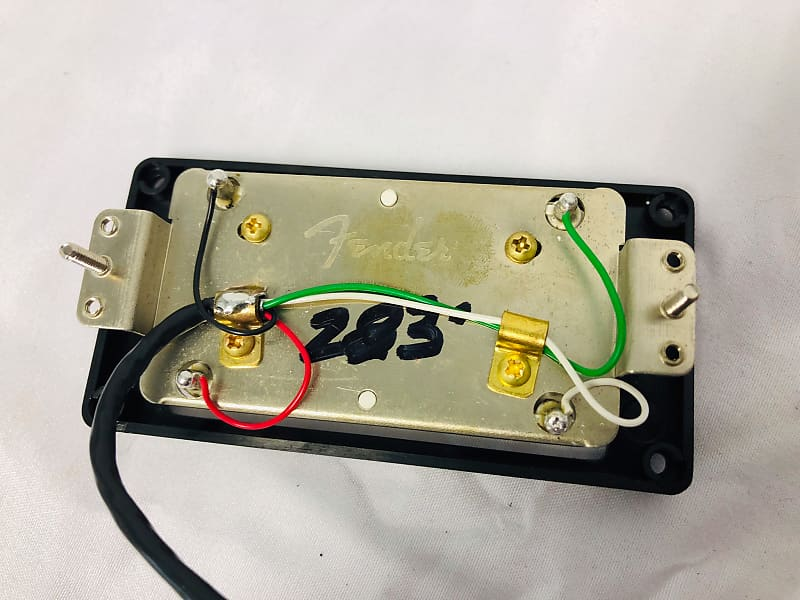
METEORA
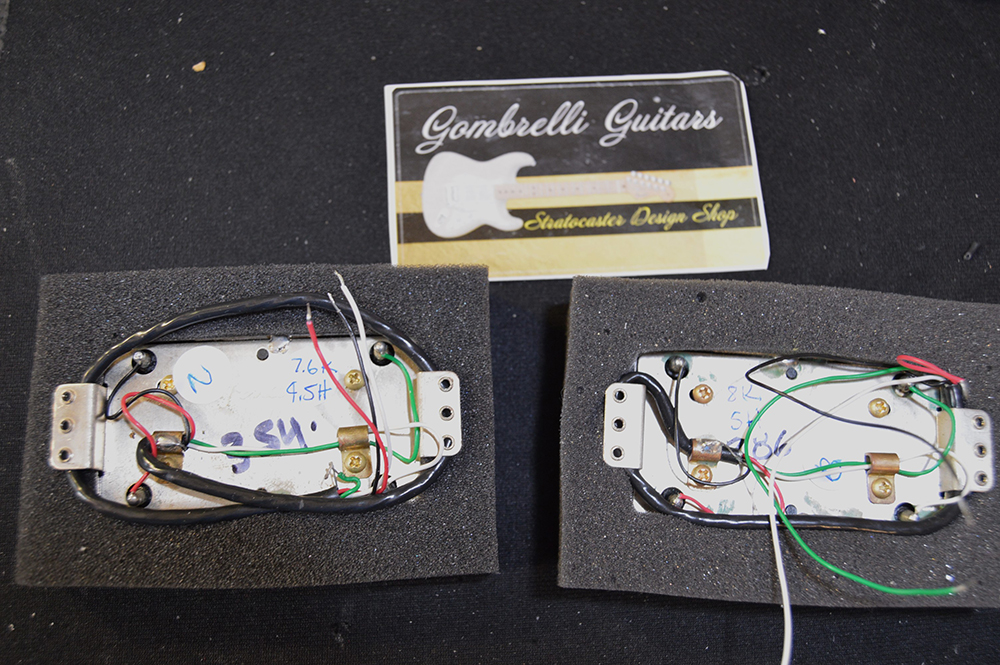
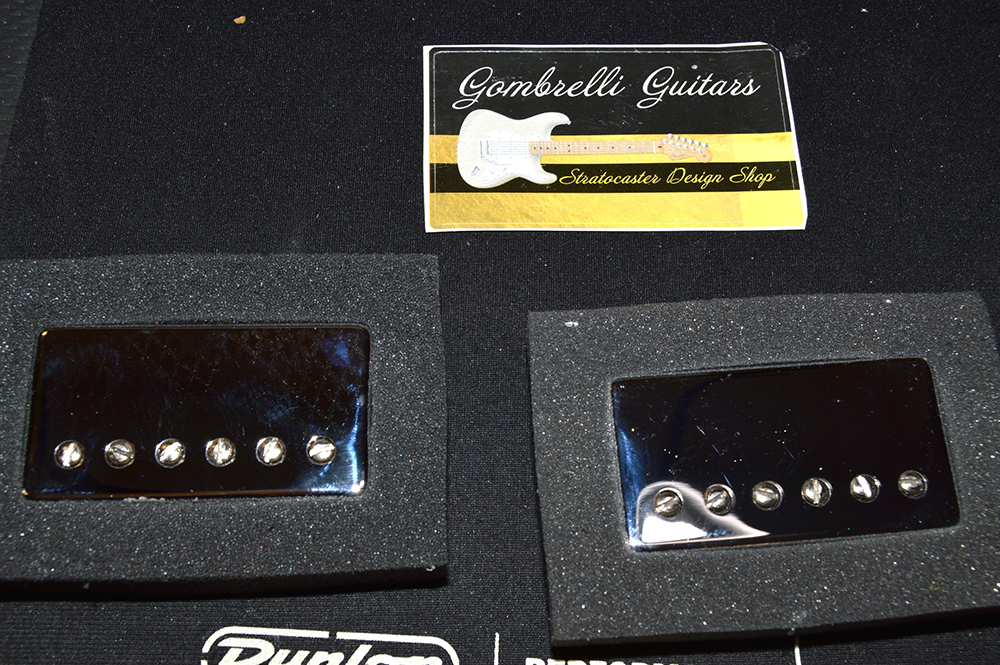
Squire Bucker
Fender Squire buckers are easy to recognize. There have 2 flat poles instead of the usual poles and screw poles on the MIM and American Strats Humbuckers. They typically measure about 9.5K but their spec vary wildly (depending on sources no doubt). They are adequate and have more sonic juice than the single coil counterparts. They are made from whatever parts, wire that is available cheapest at the time.
They only have SINGLE screw holes (one on each side)
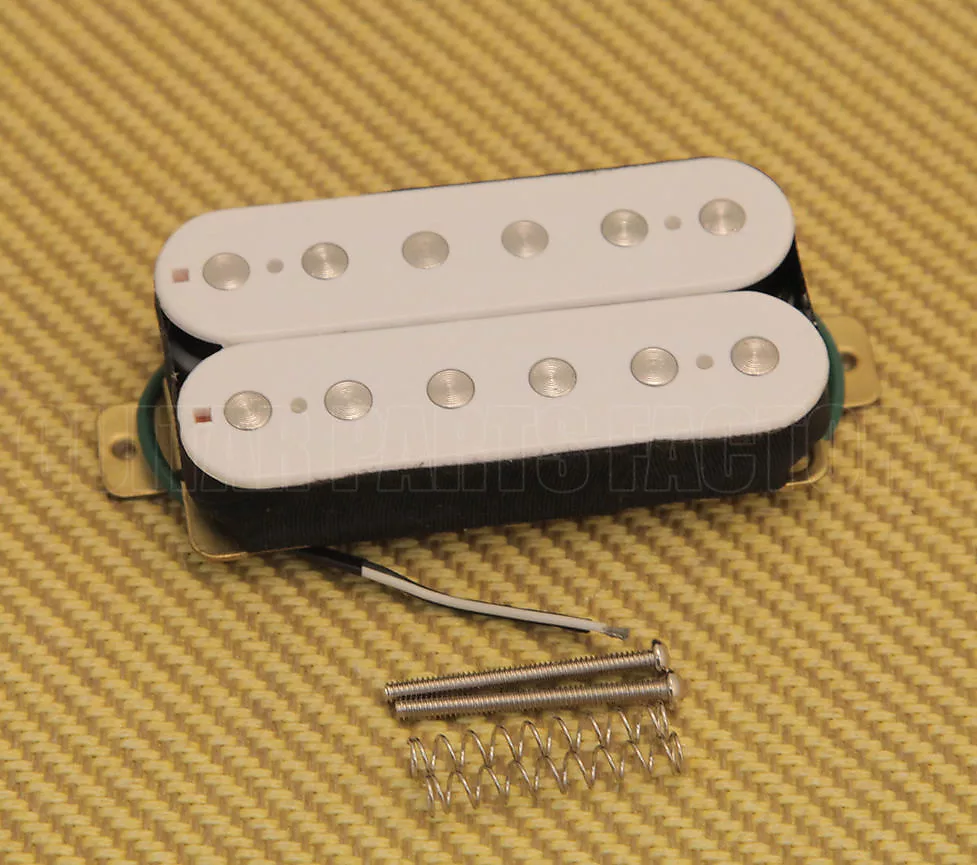
FENDER STANDARD HSS (MIM)
This is the “milk and cookies” humbucker that came with the MIM stratocasters. Ceramic. Decent pickups actually.
This is very similar to the DH-1 and it’s wiring is STANDARD (finally).
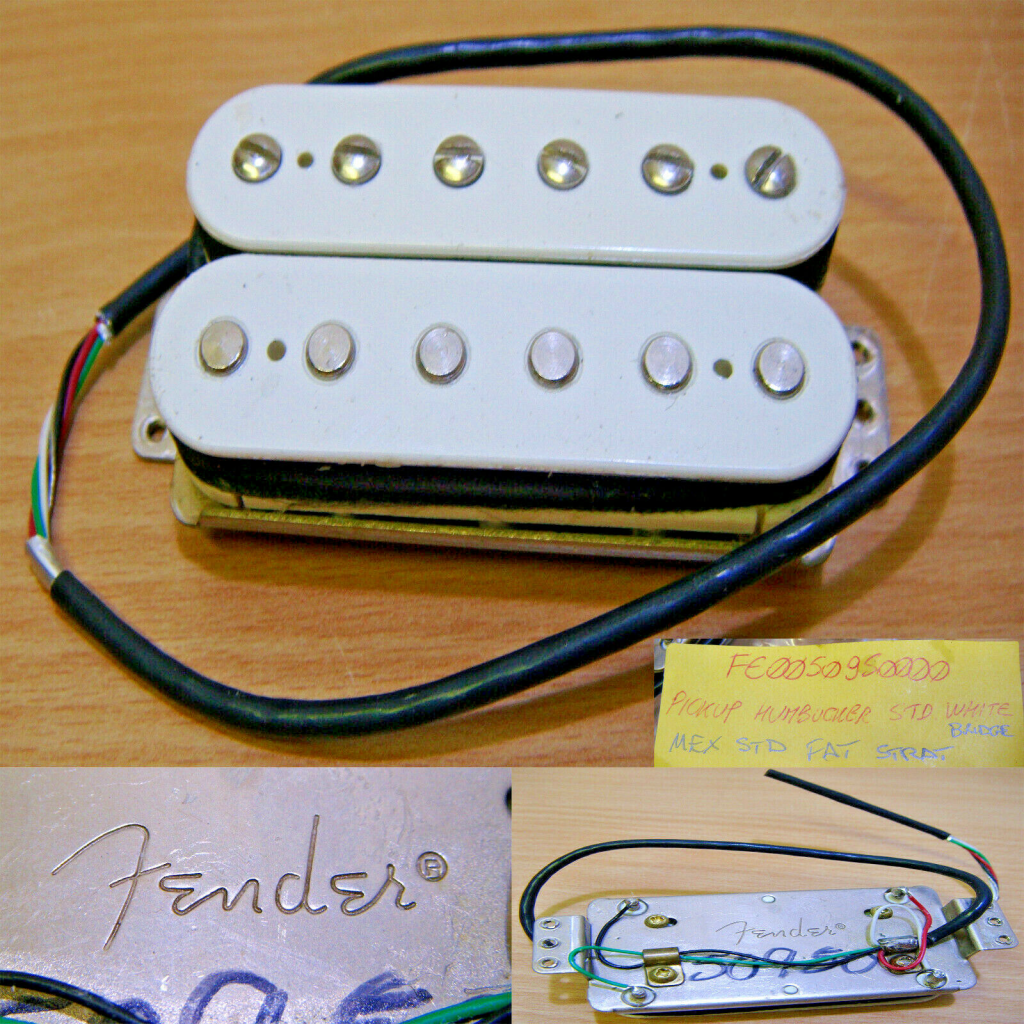
Fender part number 0050950000 Pickup, Bridge, Humbucker Std, Wide White. Found in the Mex HSS Fat Strat.
Join the black and white wires together, measure resistance on the red and green. It’s about 7.7K
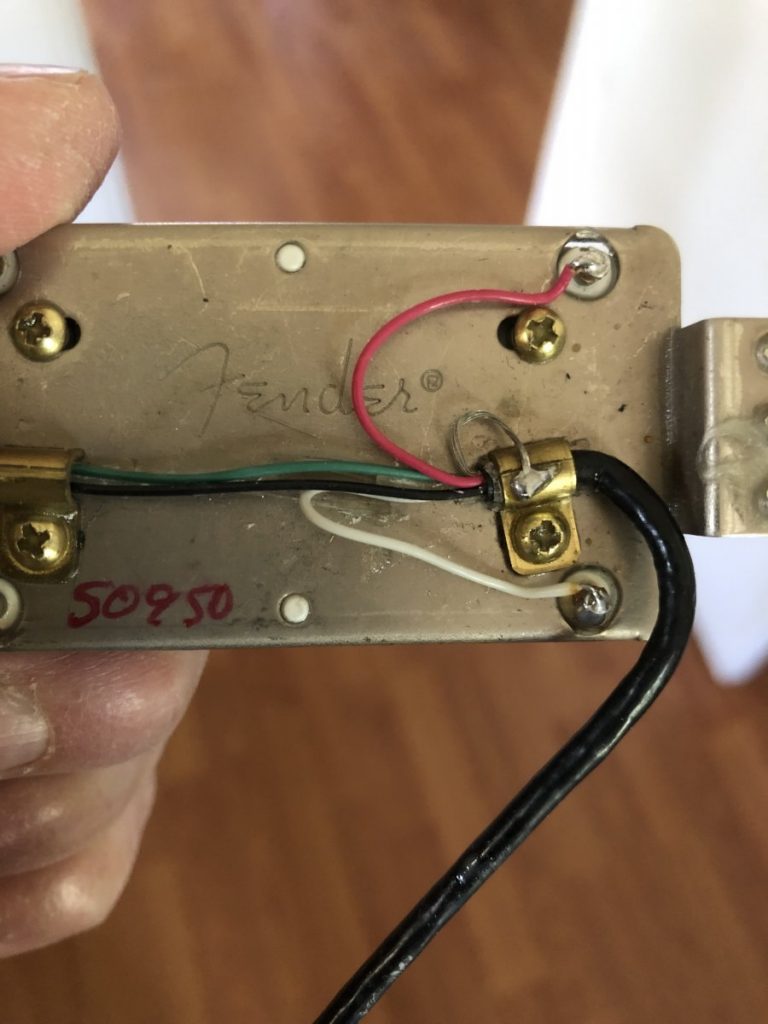
Fender Stratocaster HH Models
- 1997-mid-2000: Big Apple Strat – American Standard Strat with 5-way switch (with coil splitting) and Duncan pickups (’59 neck and Pearly Gates + bridge)
- mid-2000 to mid-2003: American Double Fat Strat – American Series Strat with same electronics and pickups as Big Apple
- mid-2003 to end 2006: American Stratocaster HH – electronics change to 2 Fender pickups (“Black Cobra” and “Sidewinder” – who names Fender pickups anyway?)the S-1 switch to activate 5 additional wiring settings (or maybe it was 4 additional settings)
- 2014-2016: American Standard HH Strat – when Fender changed from the American Series to the 2008 version of the American Standard they dropped the HH model. It came back in 2014 but with different Fender pickups (Twin Head Vintage I think) and only a 3-way switch (no coil splitting like before)
- 2016-present: American Professional HH Shawbucker Strat – current model has 2 Shawbucker humbuckers and is back to the 5-way switch with coil splitt
Double Fat Model (HH) and American Fat (HSS) (Pearly Gates/59)
Fender released a double fat version in 2000 to 2003 (as noted above). It actually uses SEYMOUR DUNCAN pickups which a ’59 in the Neck and Pearly Gates Plus in the Bridge. It’s a great combination and special wiring exists for parallel options. The 59 has a very mid dipped high EQ and neither ones are considered high output.
- Pearly Gates Plus (0992135000)
- Magnet: Alnico 2
- Bridge 8.10k
- PAF style
- More Midrange
- $99 Retail each pickup
- ’59
- Magnet: Anico 5
- Neck 7.60k
- Wax Potted
- Less Mid Range
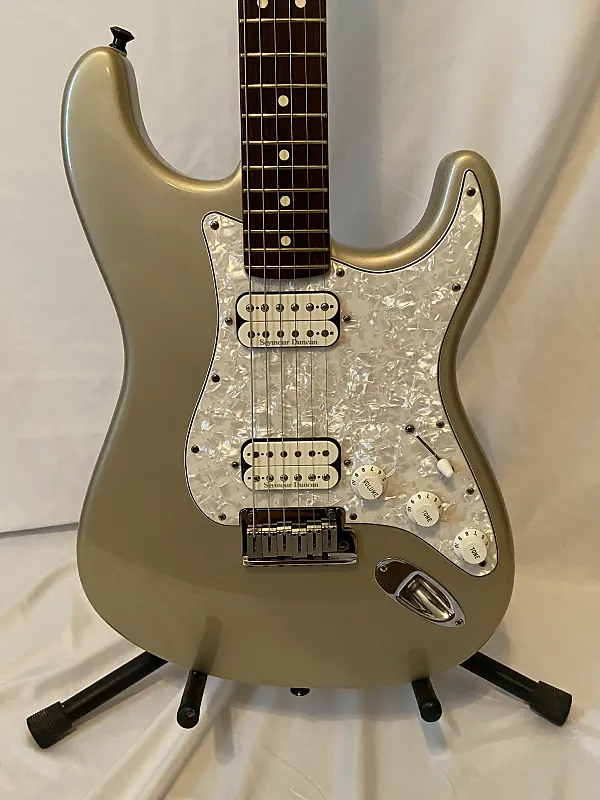
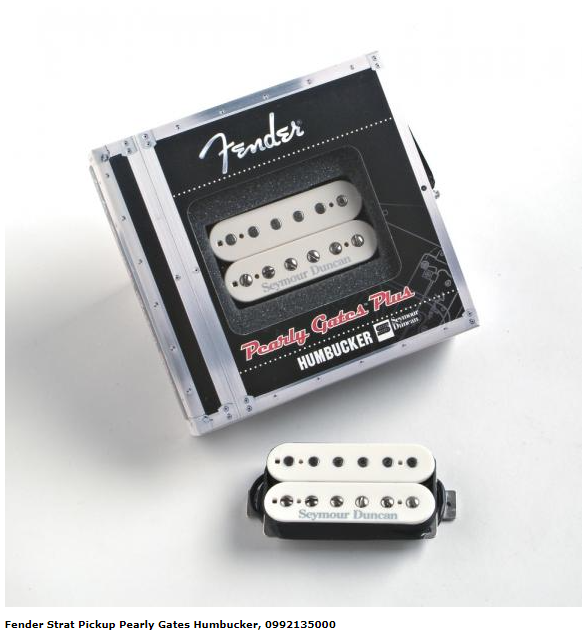
They actually used to sell this humbuckers in a packaged form and they came on the American “Fat Strat” and “Double Fat” Stratocasters
Wide Range Humbucker (WRHB)
https://en.wikipedia.org/wiki/Fender_Wide_Range
This was original release in the 1971 which ended in 1979 and has recently been re-released in a new version. There are also a BOAT load of clones out there for this one. Then there is the endless debate that the old version is the best and yet they say the new version is better. Obviously the old version is ultra expensive and the new version retails at about $199 from Fender but the they are sold at a huge range from $40 to $500 depending on the sale. In the early 2000’s the new version was only on Fender Guitars, then they released it to be sold in a retail package. The new design is NOT the same as the original.
Words of warning: Because there is a mystique around these pickups there are a LOT of forgeries in older ones. This is also my main beef around older equipment in general, guitars and pickups, is that there is a HUGE “buy at your own risk” caveat and they are often hard to identify for sure. Especially when the originals are sold at outrageous prices it’s super risky. But it’s YOUR money.
The Original: 12 CuNiFe (copper/nickel/iron) alloy magnets, wound to 10,000 turns with 42-gauge polysol wire, producing a whopping inductance of 4.85H and a DC resistance of 10.6 kilo-ohms.
Current Version (released on the Tele 72 reissues and a few other Fender Guitars) – They no longer use CuNiFe magnets, and secondly, they use AlNiCo bar magnets similar to Gibson humbuckers. Released around 2004-2005 – They did NOT get good reviews and do not sound like the original. BTW, when the originals were release they weren’t popular EITHER. Sooo…one players beautiful tone is anothers noise.
There have been quite a few “other” manufacturers like Seymour Duncan that have jumped into the pile and started producing these CuNiFe pickups which, btw, don’t scale well in mass production so it’s a good nitch market.
FINALLY. These humbuckers typically showed up on Telecaster and other Fender “wackies” like Pawn Shop series, etc, not on Stratocasters.
NOTE: 2023.06.04 – There are now reissues of the CuNiFe pickups. Fender smelled thea market and showed back up to take advantage of it!
Figuring out what is what:
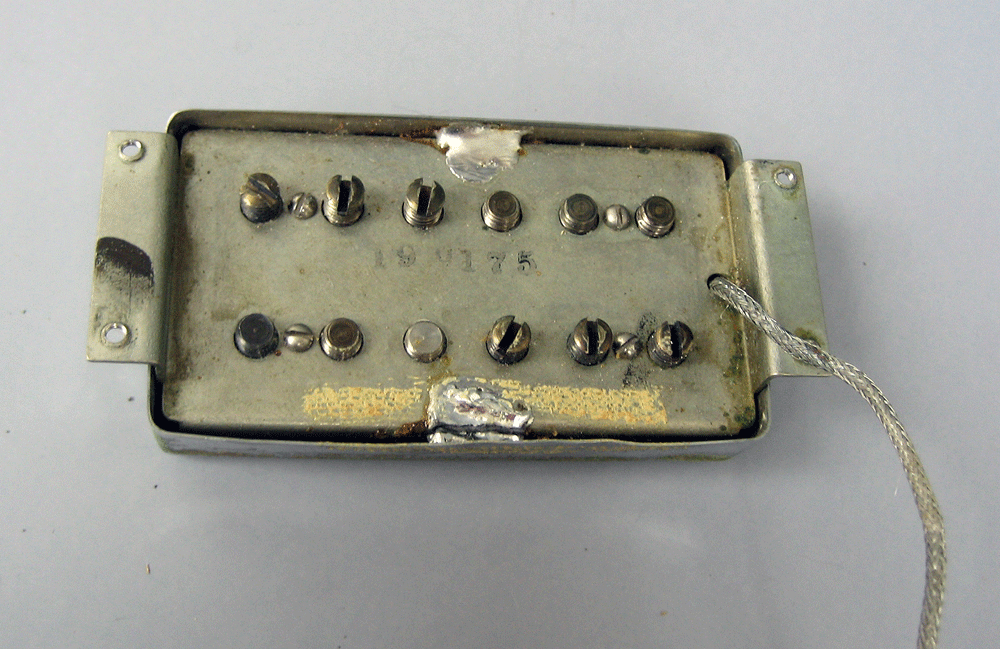
HOWEVER, you’ll find some sold with 6 digits after that that don’t conform to this and I don’t know if they are real originals. So you’ll see a TON of different serial number stamps. Which ones are original and which are fakes or clones? You tell me….Chances ARE that if there are 5 digits and the last 2 look like it’s in the 70’s range it’s a very positive indicator.
The MIJ are bar-magnet AlNiCo ones rather than CuNiFe rod magnet ones like the originals then the give-away is the depth the base is sunk into the casing. With the more modern bar magnets in there the base is almost flush with the casing. On the originals the base is sunk down inside about 1/8″ . Also the four small bobbin screws are a give-away – on the originals they are slotted steel/nickel, on the MIJ ones they are cross-head brass. The original also appears to have BRAIDED wire.
Wide Range Imports
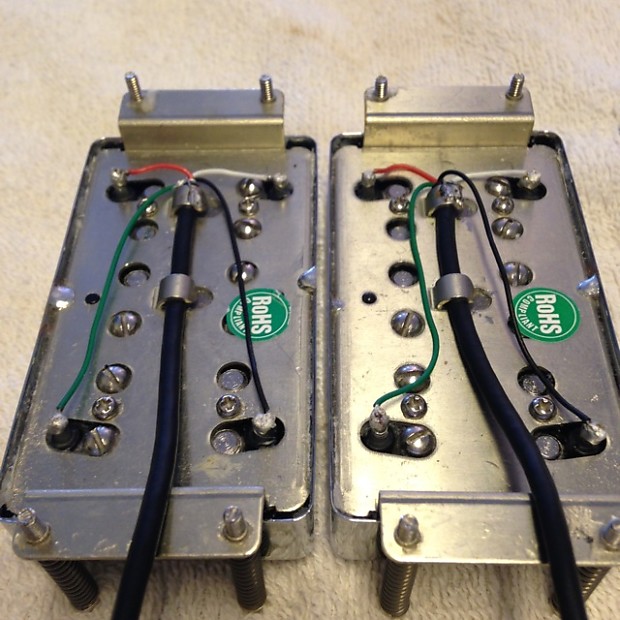
Wide Range New in a Package
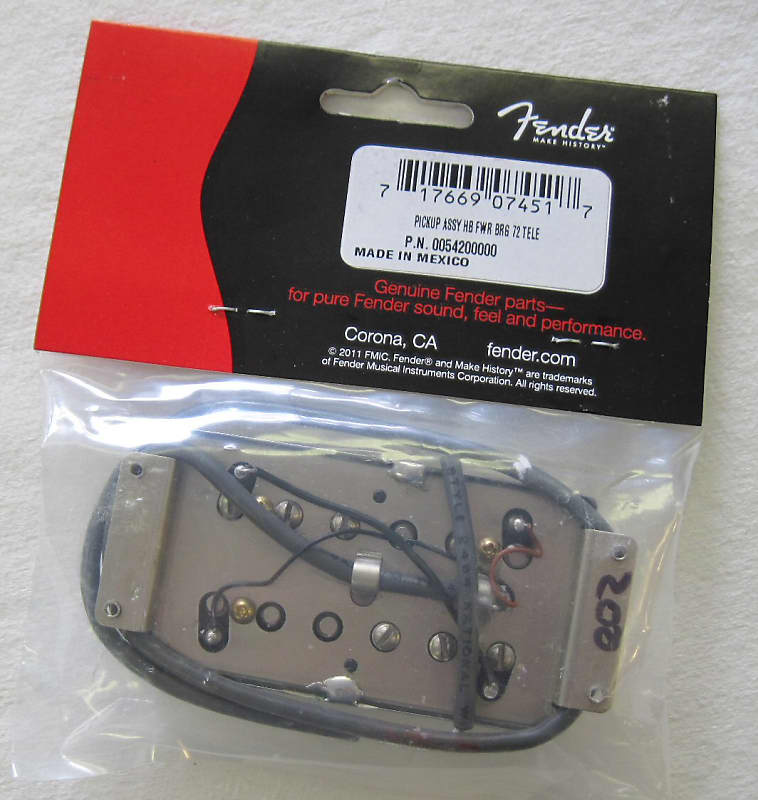
Yet one more that is a clone with no serial number and non braided wire and brass screws, and deeper dish.
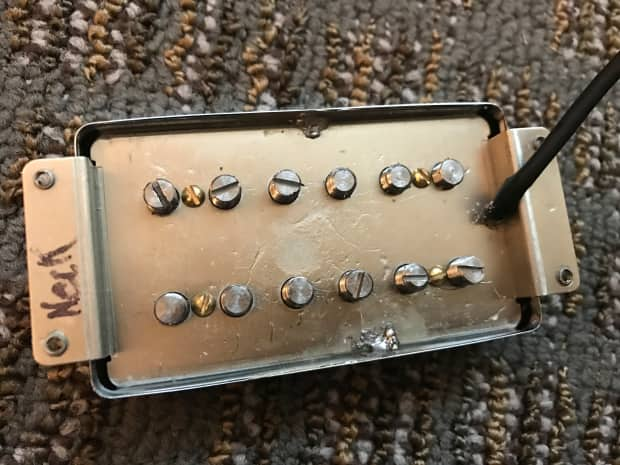
In summary. IMHO, it’s not worth the time to figure out what is what. Just buy one of the MANY wonderful Fender pickups out there and put a chrome cover on it if it strikes your fancy. Other than that, they sound fine if you like the sound of them. Do not fork out a ton of money for them! If you find an original, with 5 serial digits, etc, Sell it on Ebay for a HUGE profit LOL.
ODDITIES
BLACK CANYON
Came on a Flame Custom Maple Top HH – DCR: 8.4K (sounds like a DH-1) – INDUCT: 5.2 Henries, ANICO II
Hot Rod Wide
0054036000 (or 36 on the back of the bottom). Sold in a Retail Package. I don’t even know what this means. Hot Rod Wide? I’m sure it sounds good however.
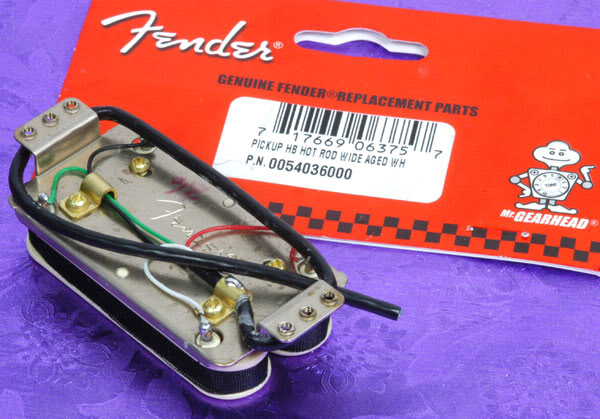
TEX MEX HUMBUCKER
These guys showed up on the MIM Deluxe Series back in the early 2000’s on both the HSS and HH models
- No Special Markings as usual, they look like any other plan jane Fender Bucker
- Listed on the MIM Deluxe series as “Tex Mex Humbucker”
- The have a mild quack to them and a Vintage sound
- DCR about 7.5K (real reading)
- In truth, this DCR could be all over the place and Fender would use what ever was available in stock sometimes and these could just be DH-1 pickups.
JAGUAR PLAYER
The look very similar to the Stratocaster Player Humbucker. The specs are completely different.
(reference the player pickup for pictures)
Specs
- Alnico 3
- DCR: 12.9K
- Inductance: 7.1H
- Bridge Position
- Fatter Logo
- Usually comes in Aged White/Cream
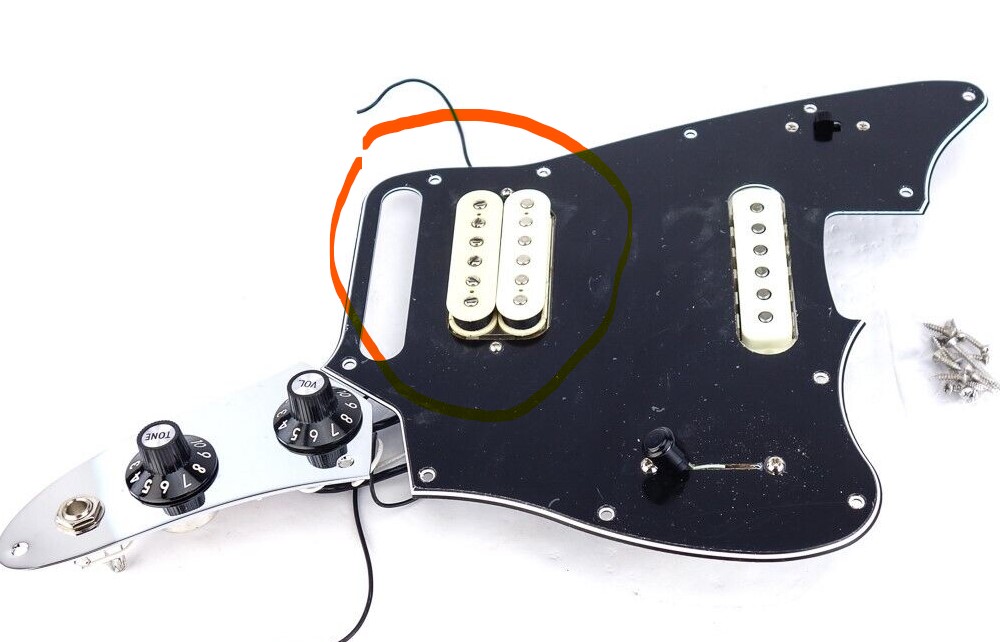
WIDE RANGE HUMBUCKERS
Years ago Fender produced what they called Wide Range Humbuckers. They have been reproduced a LOT recently so I’m adding info about them.
In Progress…
